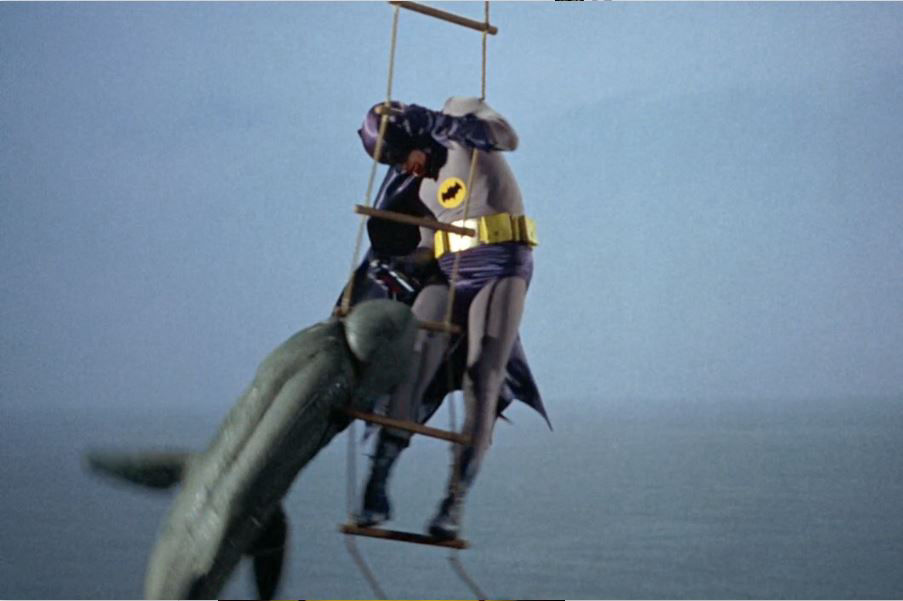
When the Batman TV series began as a mid-season replacement in January 1966 it received huge fanfare. It was a ratings smash and a pop culture icon. To top off the successful first season, they released a Batman movie at theatres. The Joker, the Penguin, the Riddler and the Catwoman teamed up to menace the Dynamic Duo. During the film Batman fights off an extremely phony-looking shark thanks to his "shark repellent bat-spray".

In the early days of the internet (1997 - the same year my Robin Hood site started), Jon Hein started a website called "Jump the Shark" The phrase was coined by Hein's college roommate -- a reference to an episode of the 1970s sitcom Happy Days where Fonzie jumped a shark on water skis. Hein defined "jumping the shark" as "It's a moment. A defining moment when you know that your favorite television program has reached its peak. That instant that you know from now on...it's all downhill."
I know a lot of Batman fans who prefer the show's first season -- it balanced the camp humour with some serious comic book storytelling. The teaming of Batman's four most popular foes in one movie was a climax. When the show began its second season only a handful of weeks after the big screen adventure, it had a lot to live up to. How do you top a supervillain team up?
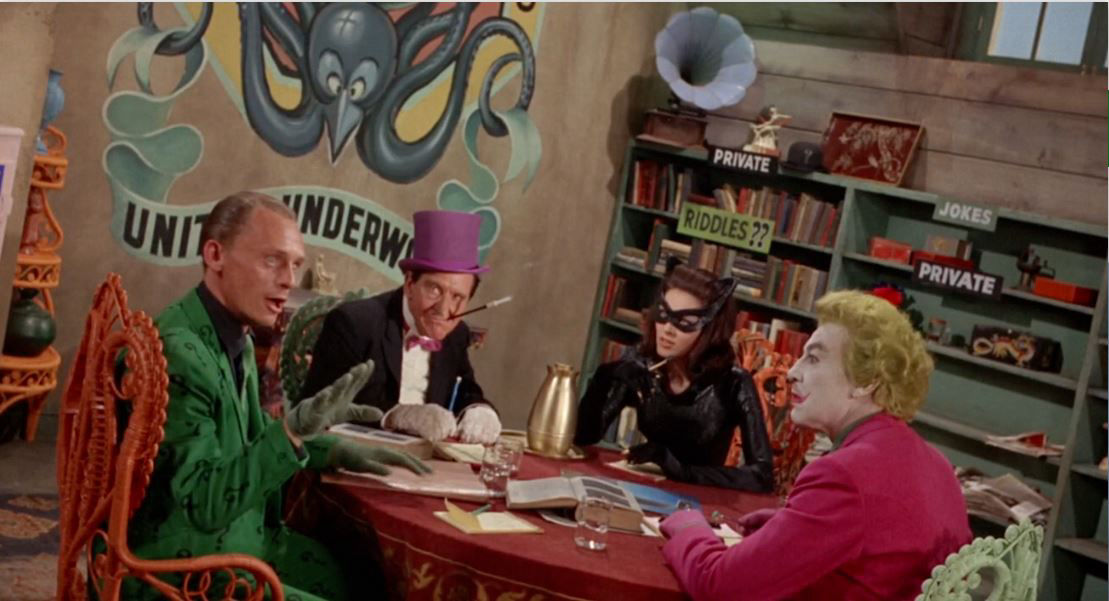
The schedulers of the second season came up with an unorthodox answer to this riddle. Instead of a big-name bad guy. they led with a new creation, albeit one that shares his name and nature with an obscure one-time Superman foe from 1941 -- the Archer.
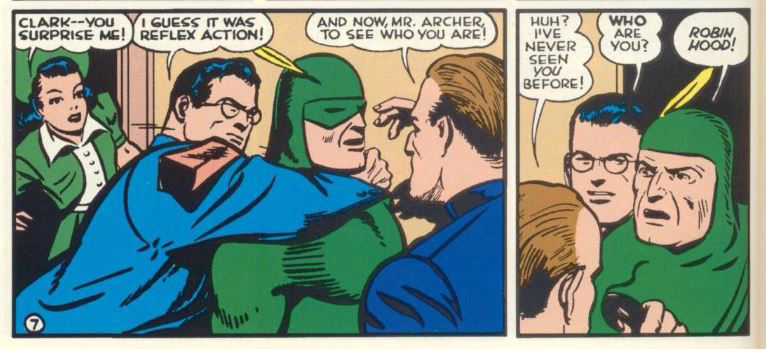
The comic book villain The Archer appeared in Superman #13, cover-dated November-December 1941 (the issue would still have been on-sale when DC Comics introduced the heroic Green Arrow over in More Fun Comics #73, also cover-dated November 1941.) Superman's foe was an assassin.
During the course of the story, a "harmless nut" claiming to be the real Archer turns up. When he's unmasked, this impostor says he's Robin Hood.
The true Archer was a hunter named Quigley -- a face the characters immediately recognized.
The Archer created by writer Stanley Ralph Ross for the 1966 Batman TV show has no connection to his comic book forebearer, other than the name and Robin Hood-like motif.But like his comic book counterpart, this Archer has a famous face. He's played by Art Carney -- a television icon for his role in the 1950s sitcom The Honeymooners and who also played Felix Ungar in the original 1965 Broadway stage production of The Odd Couple.
Like many Batman villains, Carney had an impressive career. However, writer Ross felt he was miscast, and it's hard to disagree with that assessment.
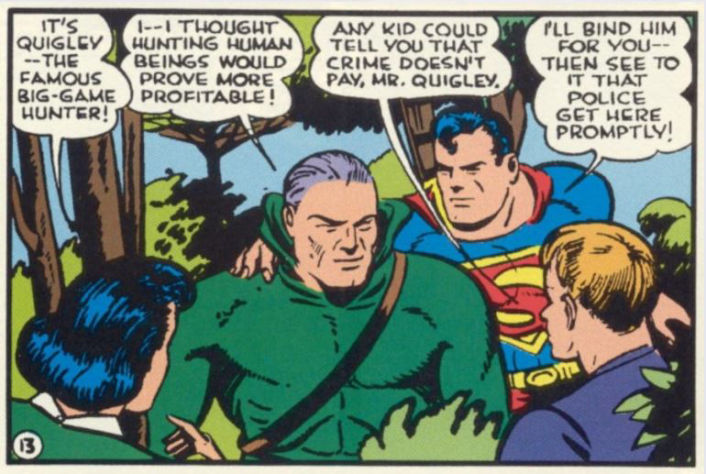
The Archer from Superman #13, 1941
Art by Leo Nowak (as Joe Shuster)
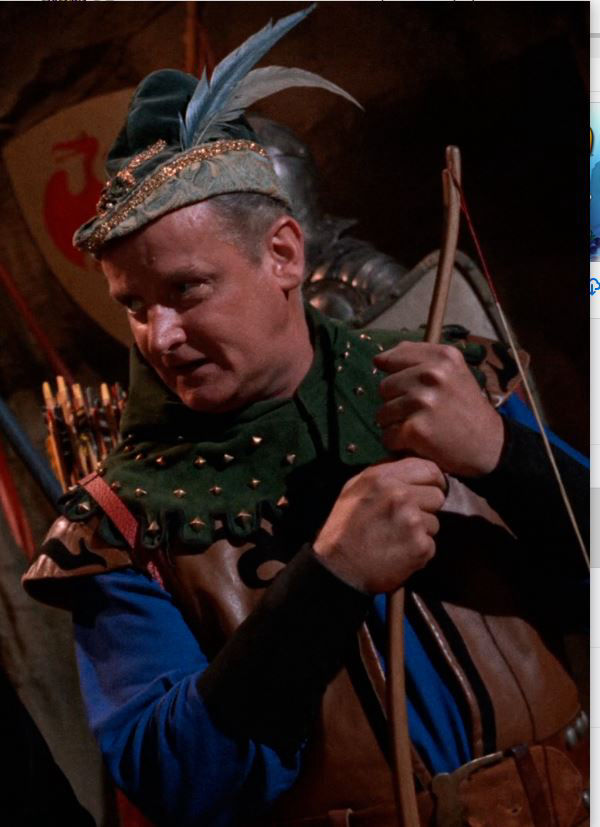
The Archer in Batman (1966)
Art Carney as the Archer
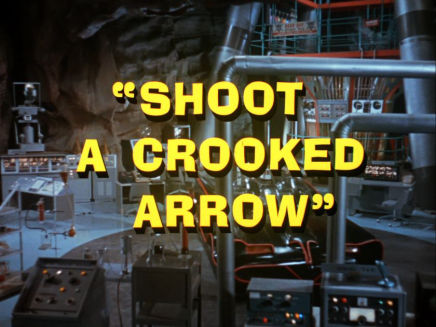
Shoot a Crooked Arrow
Air date: September 7, 1966
Written by Stanley Ralph Ross
Directed by Sherman Marks
Starring Adam West and Burt Ward
Special Guest Villain: Art Carney as The Archer
Batman episodes feature the voice of producer William Dozier providing slightly pompous narration. This episode begins with Dozier describing the verdant splendour, not unlike the early Robin Hood ballads which begin with the invocation of an endless summer.
NARRATOR: A warm, serene afternoon in Gotham City. The merest hint of a breeze ruffles the leaves of the majestic trees that inhabit the back lawn of stately Wayne Manor. Scarcely the moment for crime to rear its ugly head.
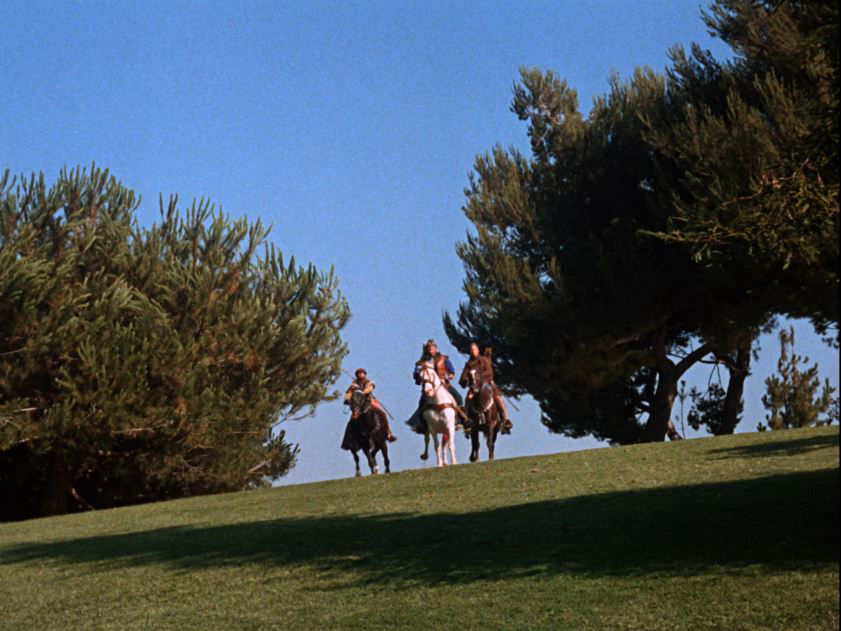
We see three men riding through the glen … well, back lawn ... garbed as Robin Hood and the Merry Men. Their leader declares “Press on, Merry Marksmen, we’ve much to do, ere night descends.” Carney and his merry band speak with American accents but even from this first line of dialogue, it’s clear that they are suffering from what Mark Twain called Sir Walter disease – speaking the pseudo-medieval dialogue one might expect to find in Ivanhoe.
Inside Wayne Manor, millionaire Bruce Wayne speaks with the administrative head of public relations at the Wayne Foundation – a fellow with the highly suspicious name of Allan A. Dale. (Bing Crosby also turned the A of Robin’s minstrel into a modern-day middle initial two years before in the 1964 film Robin and the 7 Hoods.) Actor Robert Cornthwaite speaks with an accent and attitude that could be best described as snooty, and a touch effeminate. Mr. Dale opposes the plan to donate ten million dollars to the poor of Gotham City. Bruce points out the board already voted in favour.
“Certainment,” Dale replies slipping into entirely unnecessary French. “But with this arch Archer criminal traversing our byways … I wonder if that much cash will be safe.”
The two men of business walk past Bruce’s youthful ward Dick Grayson who is taking piano lessons from Aunt Harriet. Bruce, ignoring the rogues gallery of guest villains he faced last season, declares with absolute confidence. “Gotham City is in no danger from criminals!” Bruce doesn’t even finish his sentence before an arrow strikes the piano and emits orange smoke.
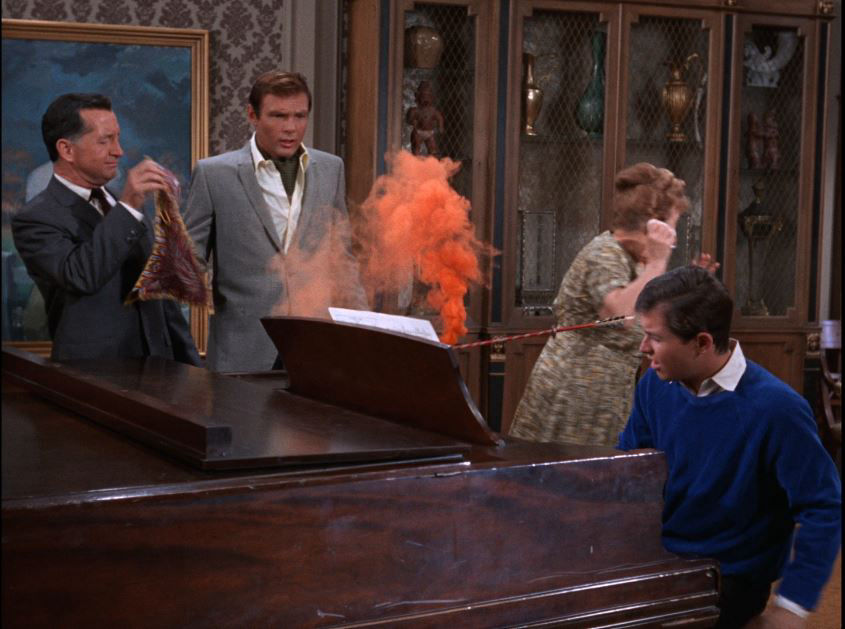
As the residents of Wayne Manor collapse to the floor, the Archer tells his men “Stand back, whilst I have at it! The legal tender awaits our liberation.”
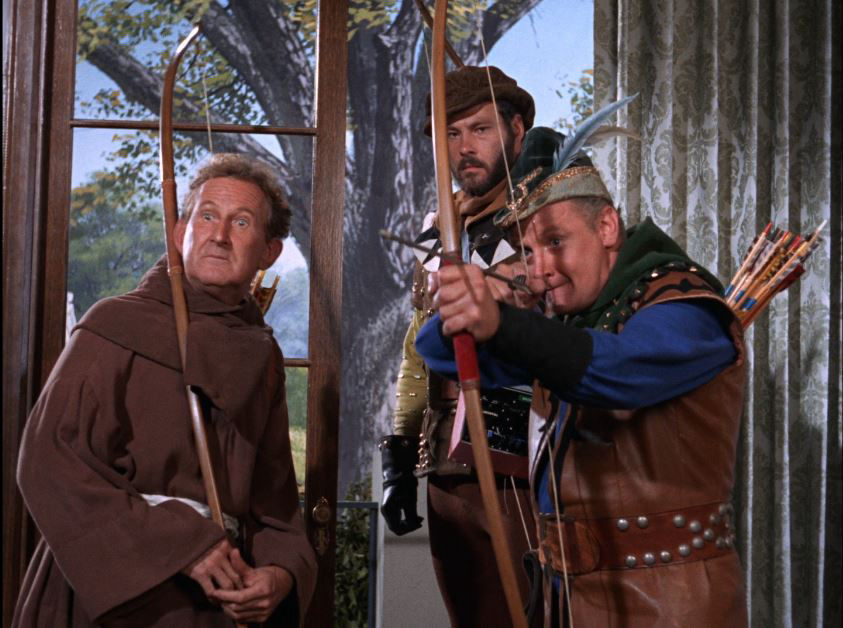
He shoots an arrow that strikes a painting with a small blast, causing the painting to fall and also opens the safe hidden behind it. The Archer places the cash into his assistant’s cassock. Then, in an act of absurdity, the Archer salutes the cheering crowd. It’s not a crowd of actual people – the victims are all unconscious. No, it’s the cheers from a recording device that Big John is carrying.
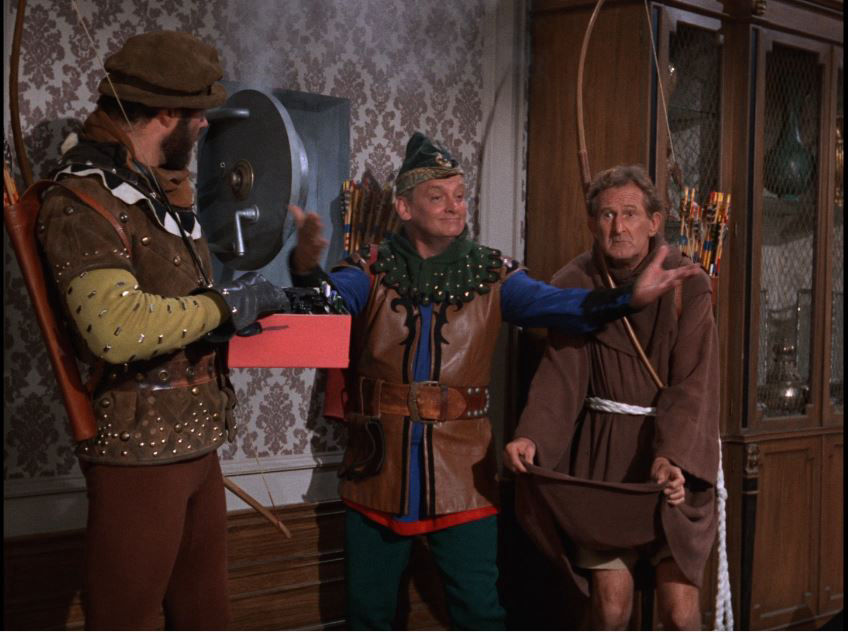
The Archer is playing a part – and almost acts like he’s in a TV show, complete with canned laughter and applause. Such antics of breaking the fourth wall, or at least knocking on it, were part of the charm of the 1960s Batman TV show. The Archer and his Merry Marksmen are like Peter Pan’s Lost Boys, playing childhood games.
The criminals take their leave, and the Archer blows his victims a farewell kiss.
ARCHER: Parting is such sweet sorrow.
BIG JOHN: Well put, sire!
ARCHER: A quote from some obscure playwright.
I suspect even most kids in the audience could name that obscure playwright – and the play.
The scene shifts to a poorer neighbourhood in Gotham City where the Archer and his crew redistribute the wealth to the city’s grateful poor.
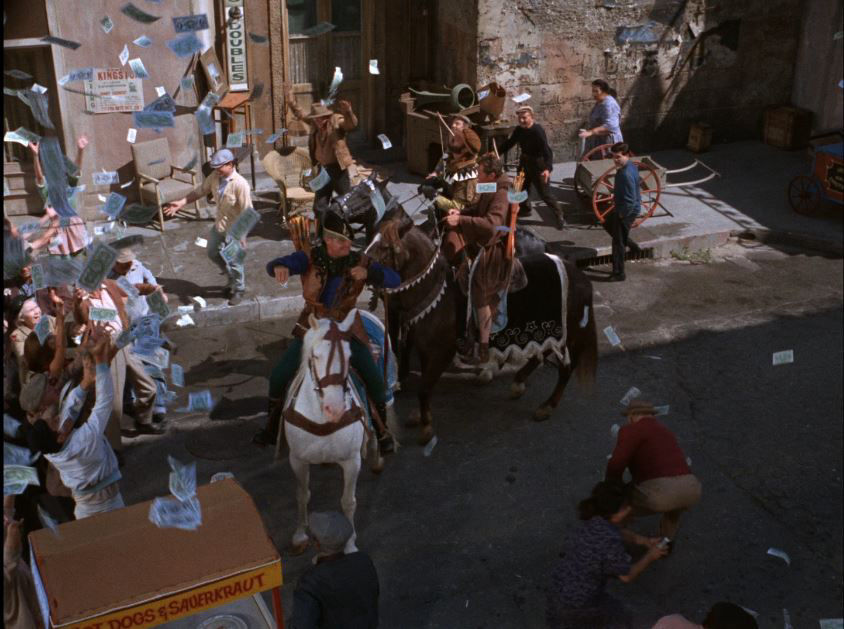
OLD MAN: Thank you, Archer! You kept the wolf from our door,
YOUNG WOMAN: You’re all heart and a yard wide, Big John!
OLD WOMAN: Ah, bless the ground that you cry on, Mr. Tuck!
Then a police car arrives and Crier Tuck declares “Egad! We are on the verge of incarceration!” These episodes would have been more successful if all the actors had played their parts with the charm and googly-eyed verve of Doodles Weaver’s Tuck.
The Archer fires a sneezing powder arrow at the cops, and then orders that the outlaws “make our egress with the utmost effect!”
Back at stately Wayne Manor in Bruce Wayne’s study, the red Batphone buzzes. As ever, Alfred the Butler answers the phone and assures the caller “I shall secure him without further delay, sir.”
In the mansion’s main room, Police Chief O’Hara is taking witness statements. (When you’re a multi-millionaire, the chief of police shows up to ask the routine questions, it would seem.) Alfred reminds Master Bruce of “that little business in the study”. Bruce and Dick take their leave. In the study, Bruce answers Commissioner Gordon’s call with his more serious Batman voice.
COMMISSIONER GORDON: I’ve just been informed by Chief O’Hara that the Archer, that rapacious rapscallion, has returned to taunt the good people of Gotham City.
BATMAN: Yes, and he robbed the home of millionaire Bruce Wayne.
COMMISSIONER GORDON: How did you know about that, Batman?
BATMAN: It’s my business to know! We’ll come right in.
Dick Grayson knows what’s coming next, and lifts the head on the bust of some obscure playwright, revealing the switch which activates the hidden panel on the wall. “To the Batpoles!” Bruce declares.
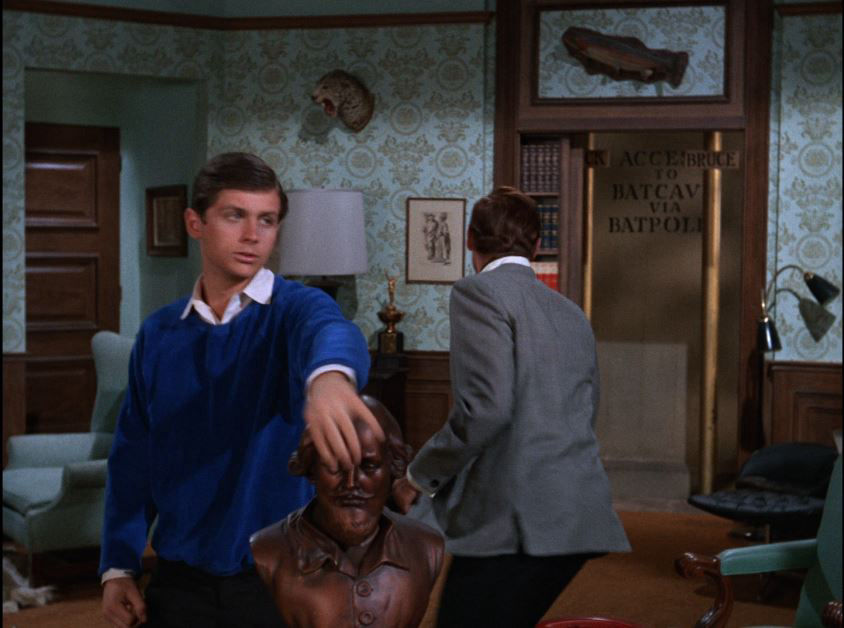
Many of the Batman episodes feature that early call from Commissioner Gordon and the race to the Batpoles. Such repetitive, stock tropes are part of the show’s style – this pop art embraces formula in the way Andy Warhol embraced Campbell’s Soup.
After the show’s animated opening credit sequence, we’re treated to another Batman trope as the Dynamic Duo emerge in the Batcave, now fully in costume. They race to Gotham City Police Headquarters in the ultra-fast Batmobile. Well, I say race, but somehow Chief O’Hara and Allan A. Dale outraced the Batmobile because they’re inside Commissioner Gordon’s office too.
BATMAN: Yet you say they distributed all the money to the poor?
COMMISSIONER GORDON: Most of it has already been turned in.
CHIEF O’HARA: Once the good people of Gotham City knew it was stolen, they wanted no part of it!
BATMAN: A tribute to their character and moral fibre!
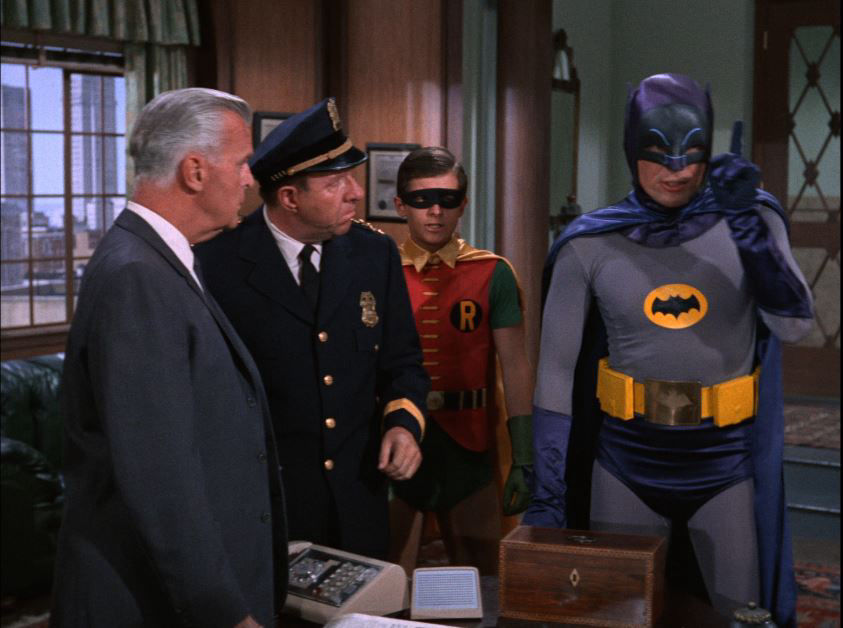
Batman and Robin work in a very different milieu than Robin Hood of legend. It’s hard to imagine the townsfolk of Nottingham returning Robin Hood’s gold to the sheriff. But Robin Hood operates in a world where the forces of law and order are corrupt and anything but lawful. Through the codes of both the Comics Code Authority and the standards of broadcast TV the forces of law and justice are to be respected. Gordon and O’Hara might be somewhat dense, but they’re well-intentioned. The TV show takes the moral strictures by governing media in the 1960s and intentionally emphasizes the moral statements to the point where they sound truly absurd. Sure, perhaps the producers gave some thought to the moral education of children, but I suspect mostly they wanted adult audiences to laugh at the deliberate corniness of it all.
Dale remarks that the Archer seems to have Batman at his mercy. He plans to cancel the distribution of the Wayne Foundation money to the poor as the money cannot be secure.
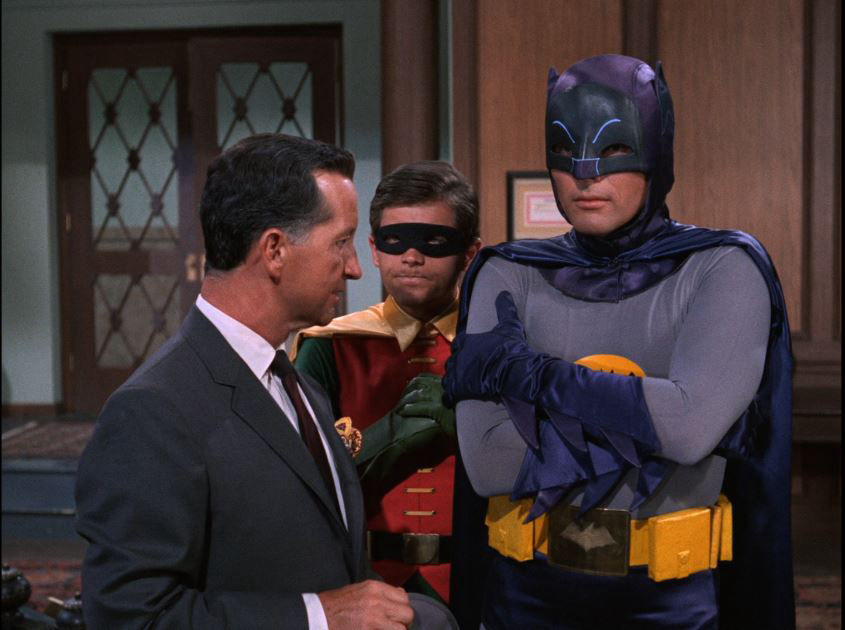
Commissioner Gordon speaks up.
COMMISSIONER GORDON: The Wayne Foundation is doing a wonderful job supplementing the administration’s policies. And with Batman and Robin on our side, you can be sure that no harm will befall that money.
And just as with the earlier scene in Wayne Manor, these assurances of safety are immediately contradicted when an arrow flies into the room and strikes the police commissioner’s desk.
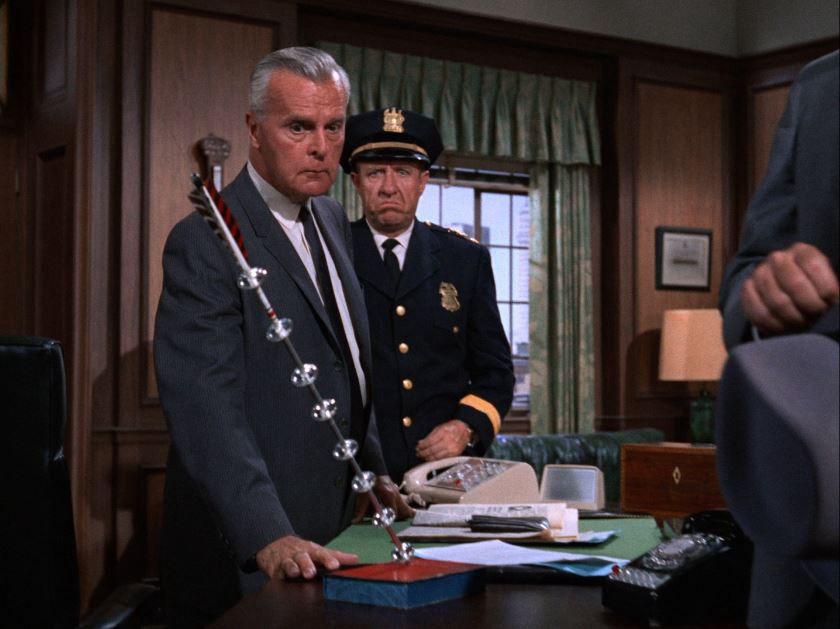
The arrow emits flashes of light and smoke that disorientate the people in the room. The Archer, Big John and Crier Tuck stand in the open window – they are wearing visors that shield their eyes from the harmful effects of the arrow. The Archer takes a staff from his band, and starts beating the incapacitated heroes.
ARCHER: Now heed this. I’m going to rob from the rich and give to the poor.
BATMAN: How unoriginal!
ARCHER: I came to warn thee. All of thee! I don’t want anybody interfering with my robbing or giving, understand? Or the poor people of Gotham City will rise up and revolt. To them, I am the spirit of benevolence, and I will brook no interference.
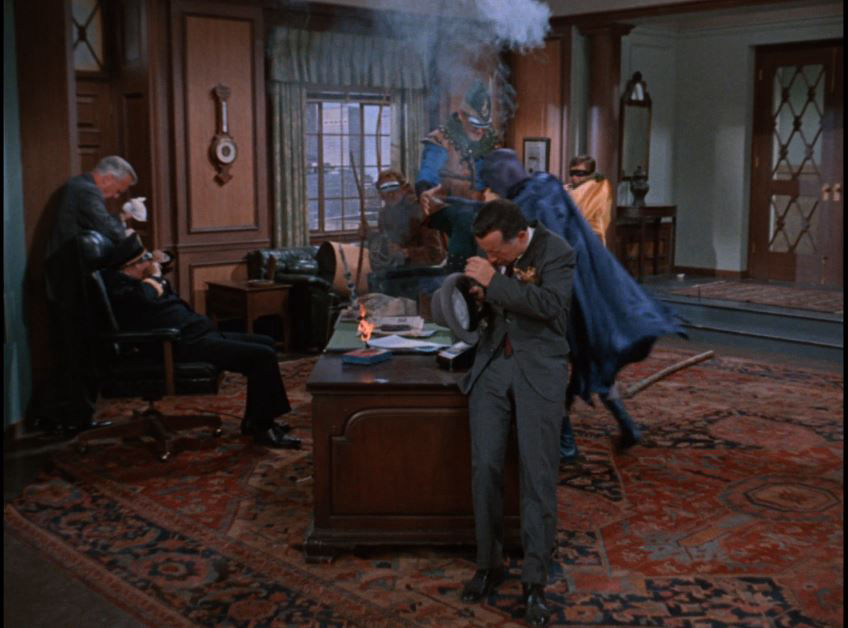
I love Batman’s “How unoriginal” retort to the Archer’s co-opting of Robin Hood’s most famous catchphrase. Robin Hood certainly appears like the “spirit of benevolence” in most modern depictions. This Archer is another matter entirely. Carney’s performance is lacking a certain something. He’s not fully committed to the idea of saying Robin Hood like speeches in a New York area working class accent (a gag more clearly realized in the script and in his cohorts than the Archer), nor does he have a Robin Hood like charm that would charm the people of Gotham City. Even the most alarming and thuggish of populists tend to have a certain charm that endears them to many – no matter how repulsive their ideas. I just don’t see that in Carney’s Archer.
The Archer shoots a rope arrow and departs through the window. When Batman and Robin recover, they follow the Archer out of the window on their batropes. Allan A. Dale glances out the window, looking down with admiration.
DALE: He certainly is a spectacular man.
O’HARA: That he is. And the Boy Wonder is pretty good too.
DALE: I was talking about the Archer. A good publicity campaign, and he’d replace Batman as the public’s favorite.
COMMISSIONER GORDON: Understand this, Mr. Dale! Someone might be able to substitute for Batman for a very short time … but no one could ever replace him.
The delight of Neil Hamilton’s Commissioner Gordon is that he delivers his lines with the earnestness of an actor doing the finest Shakespearean role. A lot of the humour in the Batman TV series comes not from people delivering their lines in a deliberately jokey way – the humour comes from the absolute earnestness. That humorous effect is entirely intended by the show’s creators. Those who seek to strip Robin Hood or Batman of all humour might wish to ponder the comic effect of complete earnestness, especially if the comic effect is unintended and unwanted.
Batman and Robin’s conversations while climbing up and down the side of buildings is another one of the stock tropes of the show, a bit of formula that tells the audience “this is a comic book”. But this is the second episode to feature a variation on these “bat-climbs” that would be used in many subsequent episodes. Their climb is interrupted when someone opens the window – the someone being a celebrity making a brief cameo.
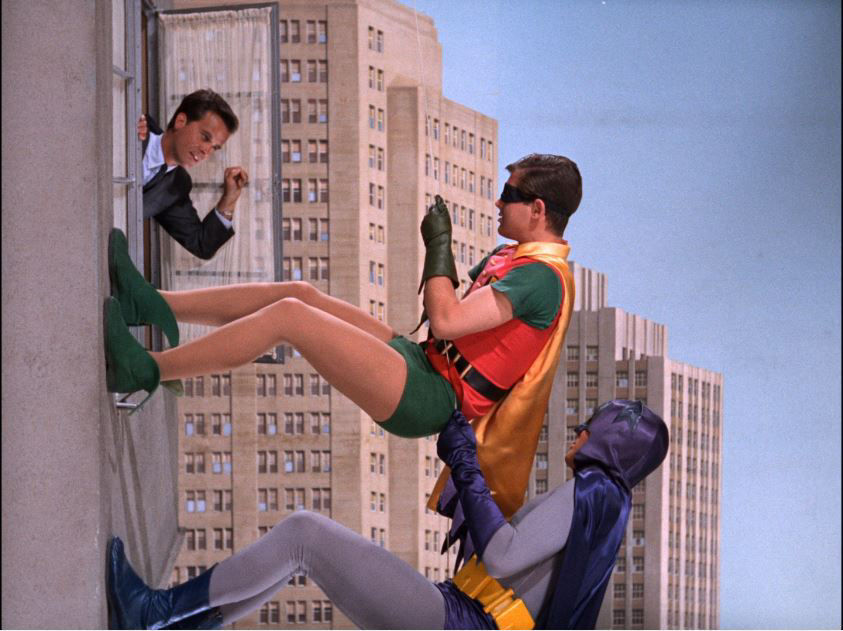
Batman deduces that the person in the window is from Philadelphia, because “you dipped your diphthong. People from Philadelphia are known for that.” Batman and Robin might not recognize the stranger in the window, but the audience at home would – it’s Dick Clark host of the popular music show American Bandstand from 1956-1989, often billed as “the world’s oldest teenager.” Clark mistakes Batman and Robin for a singing duo because of the crazy costumes, but Batman assures him that they are “duly-deputized officers of the law. You may return to your business, citizen.”
When they reach the ground, Robin declares “Holy Houdini! They’ve disappeared!”
They flag down a truck marked “Trojan Hearse”. The driver is a blonde woman eating a chicken leg. Batman asks if she’s seen three men on horseback, and she laughs off the idea of men on horseback in downtown Gotham. “I think you’ve been working too hard.”
The Archer and his band enter their underground lair, and the truck driver is still there – and still eating the chicken leg. Her name is Maid Marilyn, presumably a portmanteau of Robin Hood’s Maid Marian and the late blonde bombshell Marilyn Monroe.
BIG JOHN: Your marksmanship, for a fortnight now, we’ve robbed the rich and given to the poor.
CRIER TUCK: Yea, and with nary a doubloon for our own pocket.
BIG JOHN: Has not the time arisen for personal profit?
ARCHER: Patience and hold thy tongue! We’ve one more crime to commit before the big caper.
MAID MARILYN: I wish youse guys would quit talking so funny and get down to business.
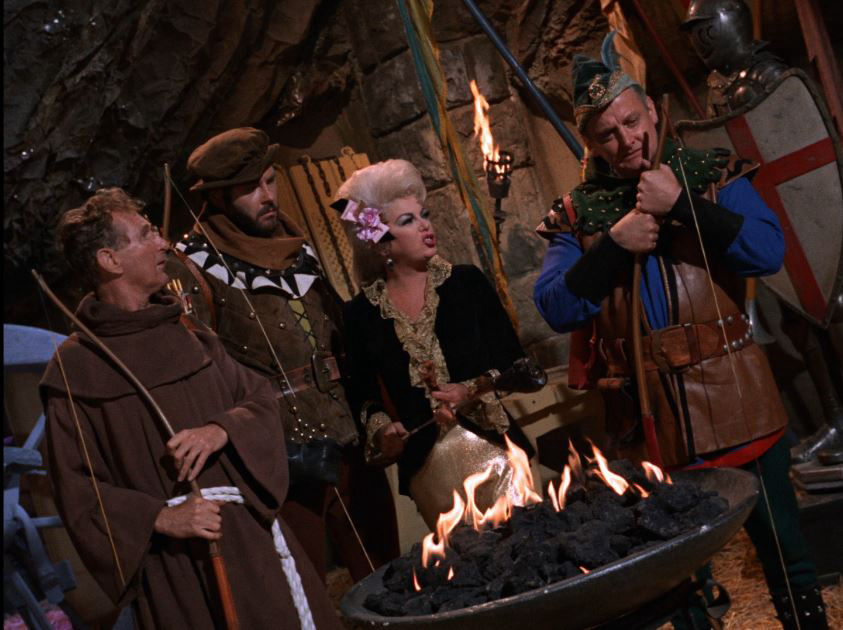
At the time this was made, it was rare – although not entirely unheard of – for Robin Hood’s men to question their leader about the need for personal profit.
Unlike her compatriots, Maid Marilyn doesn’t sound like she belongs in Sherwood Forest. She speaks with a strong Newark accent. No, I don’t mean the Newark in Nottinghamshire, nearly 28 miles from the original Gotham. I mean Newark, NJ. Her broad New Jersey accent (at least that’s what the script says it is) resembles the Brooklyn accent of the Joker’s girlfriend Harley Quinn from the 1990s Batman animated series.
The Archer tells her to cease her prattle, because he needs to discover the location of the Batcave. He explains “It is rumoured that those caped Sheriffs of Gothamham have a machine that can predict any criminals next ploy.” It's funny that the Archer feels the need to add an extra "Ham" to the end of Gotham when the place name already ends in ham, and that the original Gotham is located in Nottinghamshire, the original Gotham would have been part of the legendary sheriff's domain. In the Archer’s fantasy, it’s Batman and Robin who play the part of the Sheriff of Nottingham. They might not be corrupt like the legendary sheriff, but they are, like the sheriff, duly-deputized agents of the law.
The Archer intends to destroy the Bat-Computer. For the next phase of his plan, he asks Marilyn to call Commissioner Gordon. The Commissioner receives a tip of where the Archer will next redistribute some wealth.
Next the scene shifts to the office of Everett Bannister – the large sign on his desk informs us that Bannister is the “Koin Machine King”, and he has fortune in quarters pilled on his desk. The Archer and his men enter. Bannister tells them if they lost a quarter in the vending machine to go to the complaint’s department. A little more concerned, Bannister defends his role in the coin shortage promising he puts the coins back into circulation. “Not nearly so fast as we shall,” Big John responds. Then they pin Bannister to the wall with three arrows.
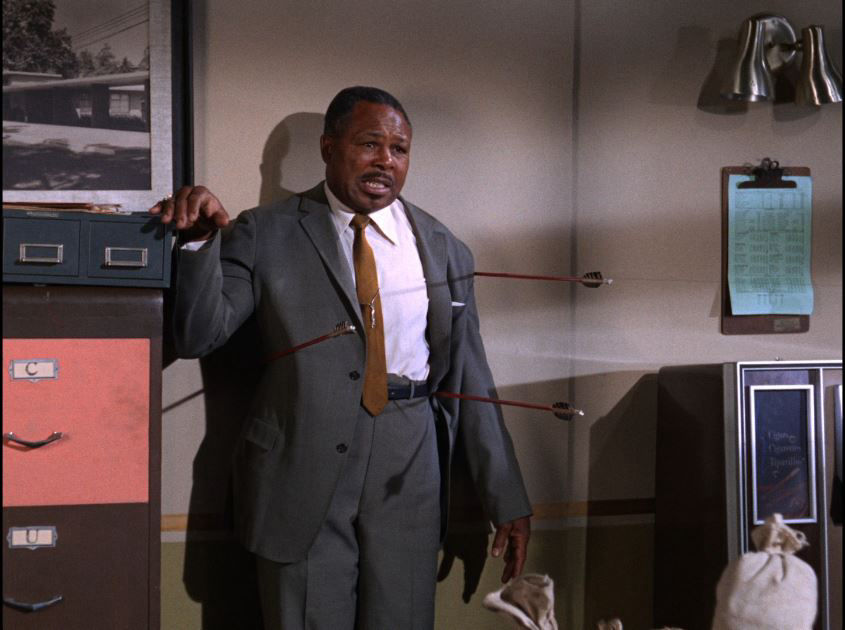
The Archer and his men grab the coins. And we next see the same coins hitting the Gotham City pavement.
The poor frantically grab at the coins. And Marilyn stands on the sidelines urging them to cheer the Archer as she plays recorded cheers on the Archer’s laugh track machine.
Batman and Robin arrive on the scene, leap onto the horses and punch the redistributors of wealth.
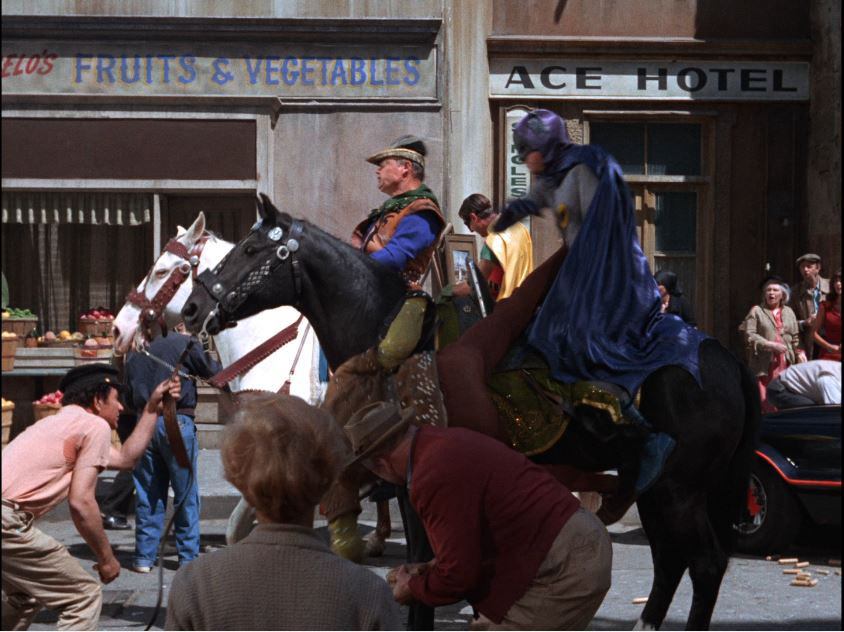
Batman punches the Archer
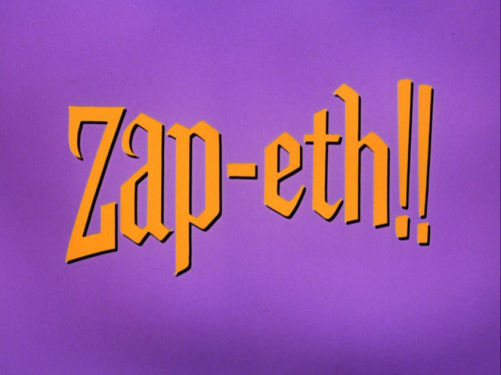
Even the action sound effects have Sir Walter Disease
As with so many episodes, the comic book like sound effects appear on the screen. But the now-familiar “Zap!” has been given a medieval make-over. It’s rendered in a gothic font. All the sound effects in these episodes have “-eth” or a Ye Olde Englishe E added to them.
Maid Marilyn switches the laugh track machine to a chorus of boo’s, and encourages the poor to start booing Batman, which some eventually do.
The three criminals are rounded up. When Batman spots Marilyn, he picks her up and dumps her with the Archer’s merry band.
MARILYN: A fine bunch of creeps youse guys turned out to be! With your fancy talk and everything!
ARCHER: What ingratitude. That’s what I get for aligning myself with a kindergarten drop-out!
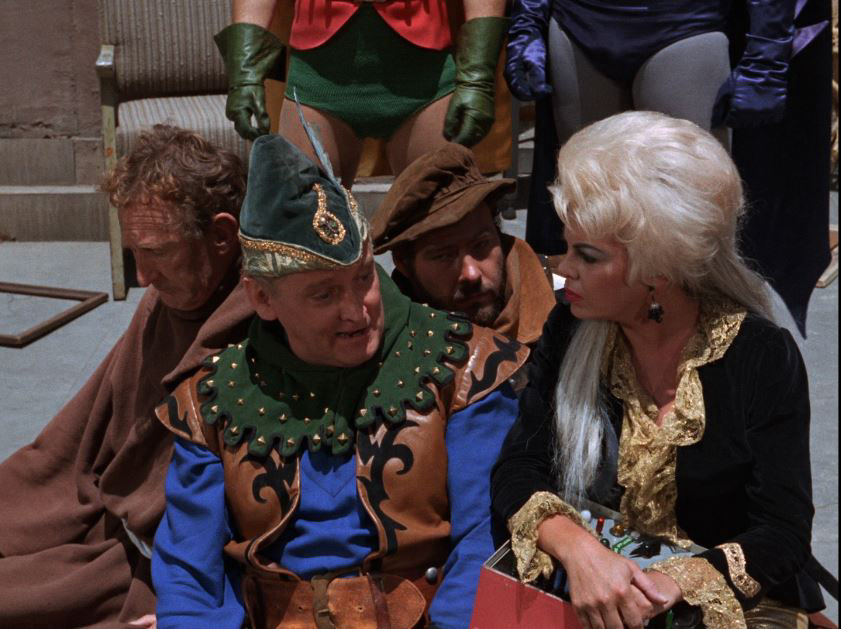
But Batman’s victory over the Archer appears to have been merely a Pyrrhic one. At police HQ, Commissioner Gordon has some bad news for the Dynamic Duo.
GORDON: The town is in an uproar, Batman. The Archer has been glorified by everyone.
O’HARA: And the poor folks have pooled their pennies to make his bail. Fifty thousand smackers in milk bottle deposit money which probably would have gone for food!
BATMAN: Don’t they understand how he’s trying to fool them? That elusive lure of easy living!
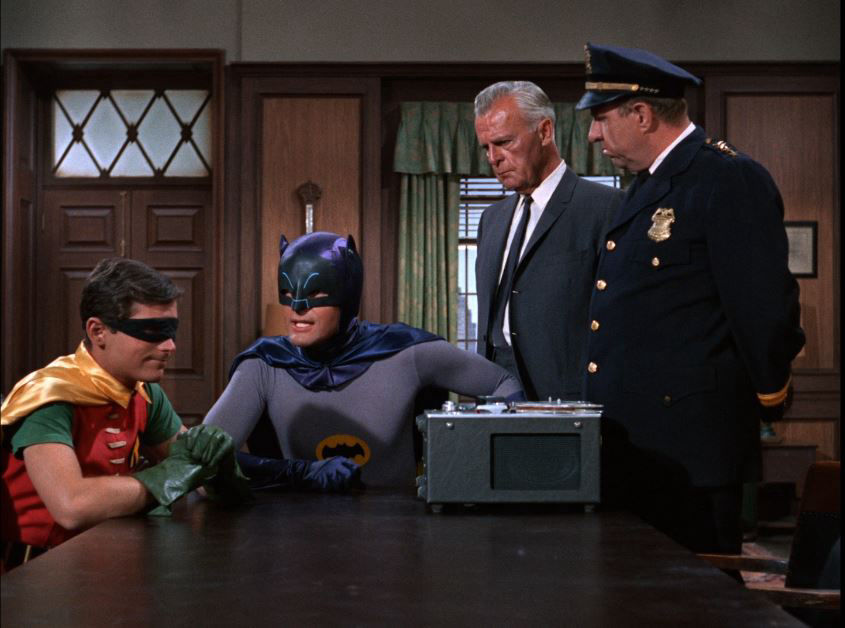
It would seem that Batman’s opinion of the character and moral fibre of the people of Gotham City has changed from earlier in the episode. The poor probably spent more money bailing out their supposed Robin Hood that they’d have ever made from their coins.
In a way this episode is very much the Robin Hood legend seen from the point of view of the Sheriff, although admittedly a sheriff less villainous than Robin Hood’s adversary.
Chief O’Hara plays a recorded message that the Archer left after getting bailed out.
ARCHER’S VOICE: Thank thee, compatriots of Gotham City. Thank thee for thy faith. Let it be known now to one and all, I have foresworn my deeds of the past. Rich people of Gotham City, thee may quake no more in thy boots. Yea and verily, I shall no longer rob thee.
It’s odd that at the point of universal acclaim that the Archer should publicly renounce the very activities that brought him such acclaim.
Back at the Batcave, Batman uses his electronic Batfile to look up all people in Gotham City with a variation of the name Archer, but Robin quickly dismisses everyone on the list as legitimate people.
BATMAN: What was it that Allan-a-Dale said about Archer?
ROBIN: The people think he may be another Robin Hood.
BATMAN: Ah! And what was Robin Hood’s real name?
ROBIN: I read about that in English class. He was also known as the outlawed Earl of Huntington.
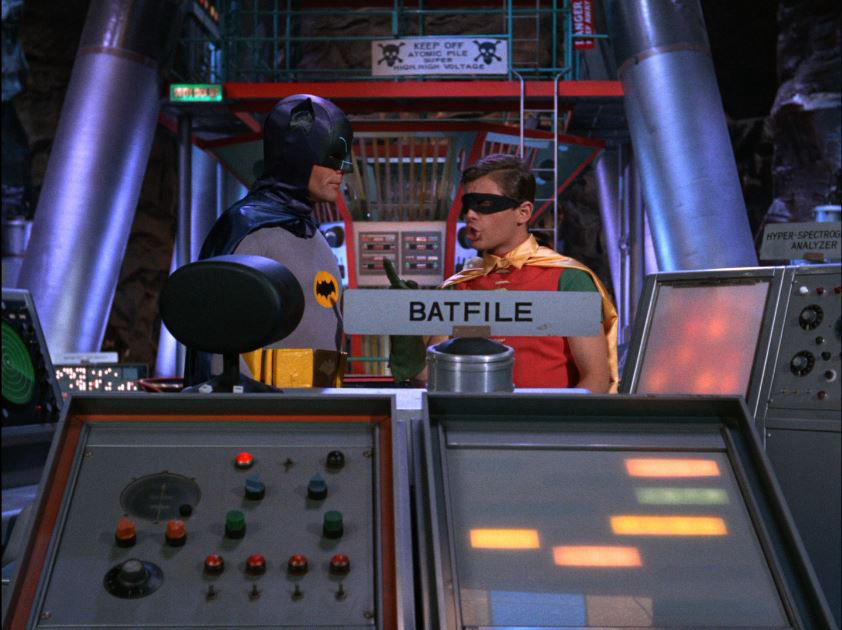
Robin Hood’s noble background as the earl of Huntington (or Huntingdon, to use the spelling of the real-world earldom) was first added to the legend in the Elizabethan plays of Anthony Munday. It’s been a frequent, although far from universal, aspect of the Robin Hood tale since then. I wonder which particular book Dick Grayson read in English class. He’s fortunate it was one that used the Huntington name and not the Robert Fitzooth or Robin of Locklsey background for the outlaw hero. It’s unfortunate for Batman and Robin that presumably the character of Allen-a-Dale did not appear in that particular Robin Hood book, or they’d have guessed Mr. Dale’s criminal ties.
Batman reprograms the Batfile and comes up with Earl Huntington Archery Range at 88 Sherwood Avenue, which Batman adds is in the Green Forest section of Gotham City. It seems a promising lead, although I don’t think you’d need to be a master criminal to name an archery range after the most famous archer of legend.
The Boy Wonder explains the problem to Alfred the Butler.
ROBIN: The Archer has sworn never again to rob from the rich and give to the poor.
BATMAN: But he had nothing to say about robbing the poor to make himself rich!
ALFRED: You think that may be his overall plan, sir?
Taken at face value, that would be an absurd plan. As critics of Robin Hood have pointed out for centuries, there’s no inherent justice in robbing the rich instead of the poor. The rich have far more to take. But Batman speculates the plan will likely involve the Wayne Foundation grant – money that the rich were willingly distributing to the poor.
Batman remembers that in his youth Alfred was familiar with “the long, the short and the cross bow”. The butler confirms with pride that he was known as “the William Tell of Liverpool” – a reference to legend’s other famous archer.
Alfred is eager to help Batman as he searches for the Archer’s hideout.
The butler arrives at the Earl Huntington Archery Range, which is indeed staffed by the Archer and his crew, and announces he’d like to purchase a few shillings worth of arrows.
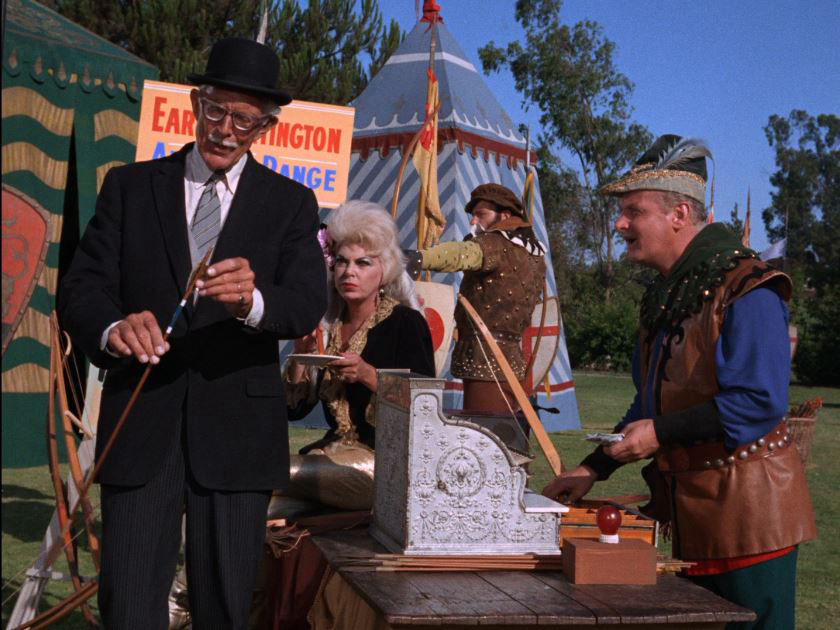
ARCHER: Dost thou fancy thyself a bowman?
ALFRED: Yes. Of the highest caliber.
ARCHER: I’ve yet to meet a man who’s my match.
ALFRED: You may have met him now.
They agree to wager a pound note (which looks like $100 bills) on the outcome of their archery match. The tropes of the archery contest and of Robin Hood meeting his match runs through the legend from the earliest ballads to the most recent TV shows.
The Archer’s men discuss the contest that’s about to take place.
CRIER TUCK: Does the heathen stand a chance?
BIG JOHN: Not a smidgeon. Archer will soon puncture his confidence.
MARILYN: You know somethin’? Youse guys ought to use American titles under youse when youse talk. Like in the foreign pitchers.
Marilyn’s suggestion would only work in a TV show or movie, where you could project subtitles under them. It’s another bit of 1960s Batman humour that pushes against the fourth wall.
Batman and Robin enter the Archer’s underground lair, and they note the many historical torture instruments around.
Meanwhile, above ground, Alfred distracts the Archer by landing an arrow right in the bull’s eye. Although the Archer’s unimpressed calling it, “mediocre, sir.” The Archer tops him by sending an arrow straight down Alfred’s shaft, splitting the first arrow in twain. The imagery of the split arrow appears in one version of the Robin Hood and Queen Catherin ballad, but it achieved wide prominence in Sir Walter Scott’s 1819 novel Ivanhoe. Robin Hood has split many opponents’ arrows in novels, film and television ever since.
Alfred shoots again and this time splits the Archer’s arrow. The Archer gripes “We lose more arrows that way.” He declares that whoever misses splitting an arrow is the loser.
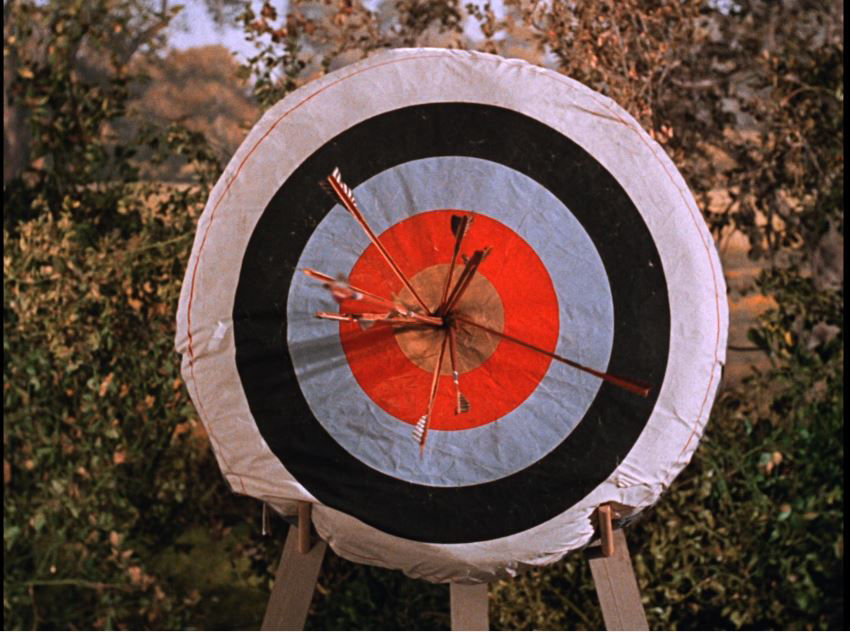
The idea of multiple arrows being split also occurs in the 1993 comedy Robin Hood: Men in Tights and the 2014 episode of Doctor Who “Robot of Sherwood”. And also, Batman's team up with Robin Hood in the issue covered here.
A red light flashes next to Marilyn, and she lets the Archer know that someone is sneaking around his headquarters. On the Archer’s orders, she opens the cash register which triggers a net in the underground lair to ensnare the Dynamic Duo. Batman says he’ll free them with his Bat-Knife.
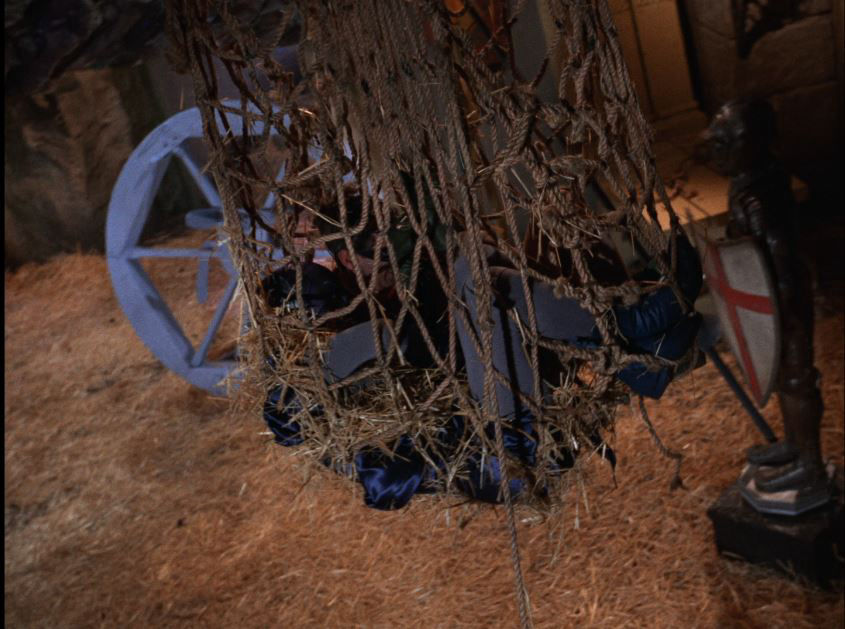
Alfred tries to leave, saying he has a pressing engagement. But the Archer quotes the Three Little Pigs and tells Alfred “Not by the hair of thy chinny-chin-chin.” The Archer correctly deduces that Alfred was sent as a distraction, even as the butler protests that he’s merely an innocent bystander.
The Archer, his men and Alfred enter the lair. When Archer sees Batman and Robin swinging in the net, he takes aim at his foes.
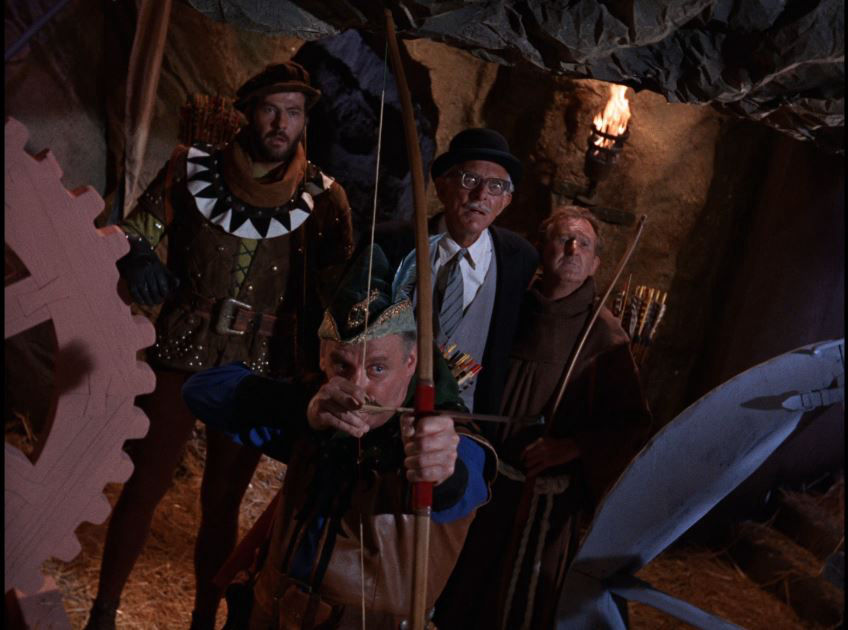
But the Archer merely shoots the rope holding the net to the ceiling. He chuckles over the unconscious heroes on the floor before him.
Apparently during the commercial break the Archer tried various means of torture to extract the location of the Batcave from the heroes. Batman declares he’ll have to kill them to get that information.
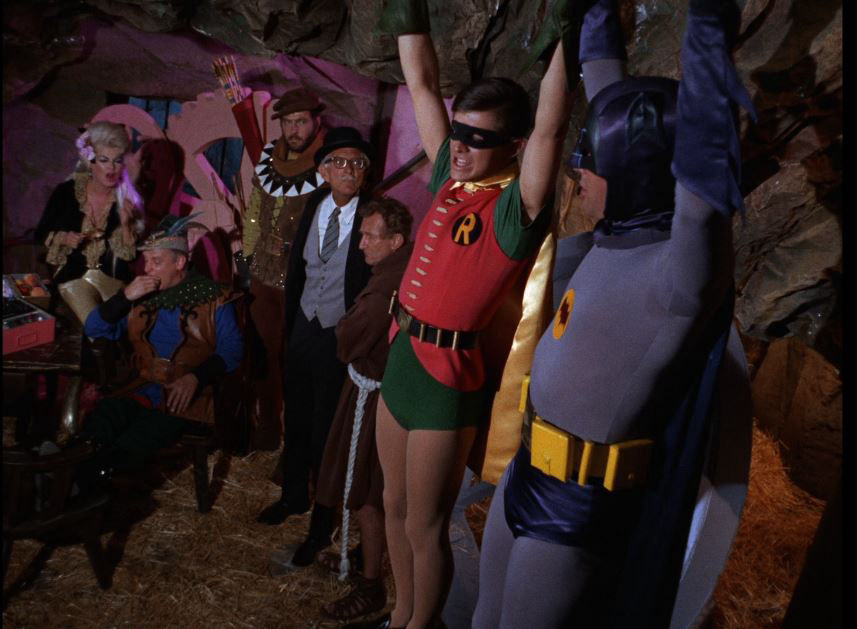
But the Archer has a better idea. He’ll kill “innocent bystander in thy stead” if Batman doesn’t talk. They place Alfred’s head in a guillotine. Robin insists that Batman can’t let them do it, but Batman replies that the decision is up to the innocent bystander. “I would rather lay down my life,” Alfred declares, “than impair the efficiency of Batman and Robin.”
The guillotine falls, and Robin declares “You’ll pay for this, you fiends!” But Batman is surprisingly calm. Or not that surprising as it turns out that Alfred is perfectly fine. Batman explains that it’s a guillotine used by stage magicians – and he recognized it immediately. A harmless prop that would normally represent a deadly threat on TV is revealed to be, just a harmless prop.
The Archer orders his men to “let the varlets down.”
BATMAN: Archer, I’ve been meaning to ask you about that machine. What is it?
ARCHER: I purloined from the castle of a television producer – who makes alleged comedy programs. It can duplicate any laugh from a giggle (plays a giggle) to a guffaw (plays a more robust laugh) and all the chortles and chuckles betwixt and between.
I imagine Carney’s Archer seizing this device from the producers of his old show The Honeymooners, perhaps from the home of Jackie Gleason himself. The Archer is very much a man who is putting on an act, pretending to be a medieval gentleman – it’s appropriate that he’d surround himself with the accouterments of the entertainment industry.
Big John recommends that the Archer encase them in a room filled with imported California smog, because they wouldn’t last five minutes. It’s another wink at the reality behind the fictional world. Gotham City is a stand-in for New York City, but this TV show is actually filmed in California. They wouldn’t need to import the smog – just open a window.
Instead, the Archer borrows from another trope of medievalism. “Batman, I offer thee a sporting proposition. A fair duel on a field of honour.” Then, he smacks Batman in the face with his glove.
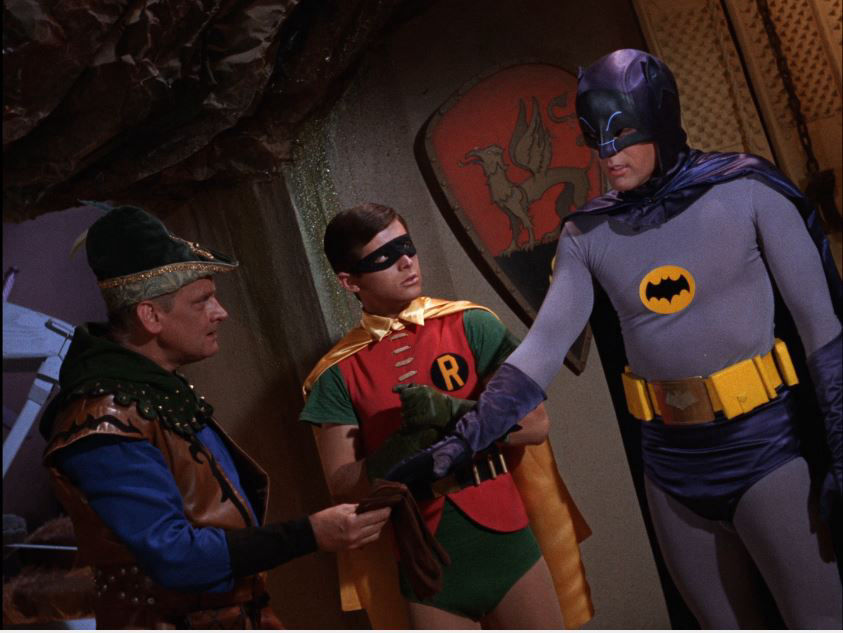
Batman accepts the challenge and the glove, and then throws down the Archer’s gauntlet.
The duel is less fair than promised. Batman and Robin are on a jousting field … but they are tied up to stakes.
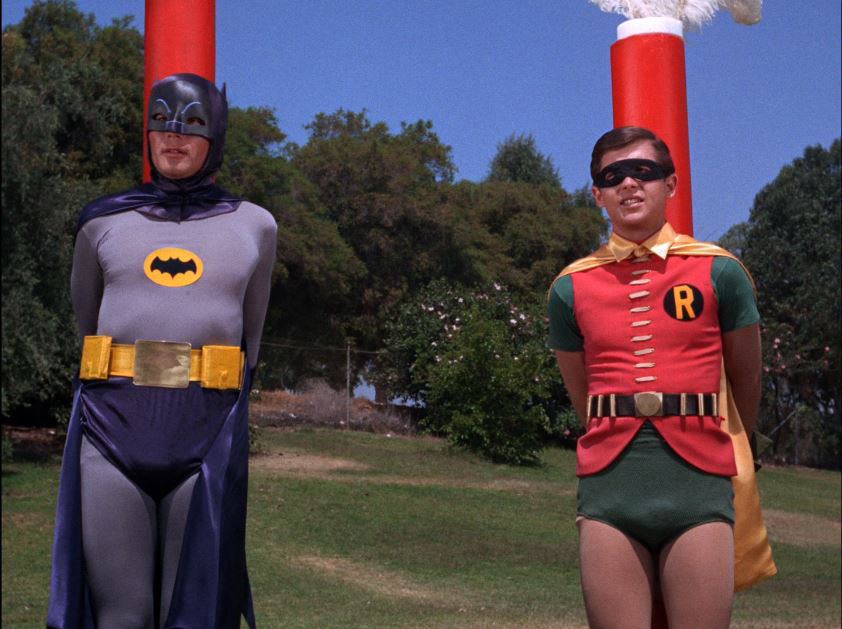
Maid Marilyn plays cheers on the laugh-track machine, as the Archer and his men are on horseback, carrying lances. “Let’s smite the varlet!” The criminals ride forth, to a jousting tournament less fair than any Ivanhoe faced.
The narrator asks:
Doth this foul deed spell finis for the Caped (pronounced KAY-PED) Crusaders?
Whillst the Dynamic Duo escape to fight again the villainous swine who threaten home and hearth?
Take heart, citizens! The answers to these and other pointed inquiries tomorrow!
Same Bat-Time! Same Bat-Channel …!
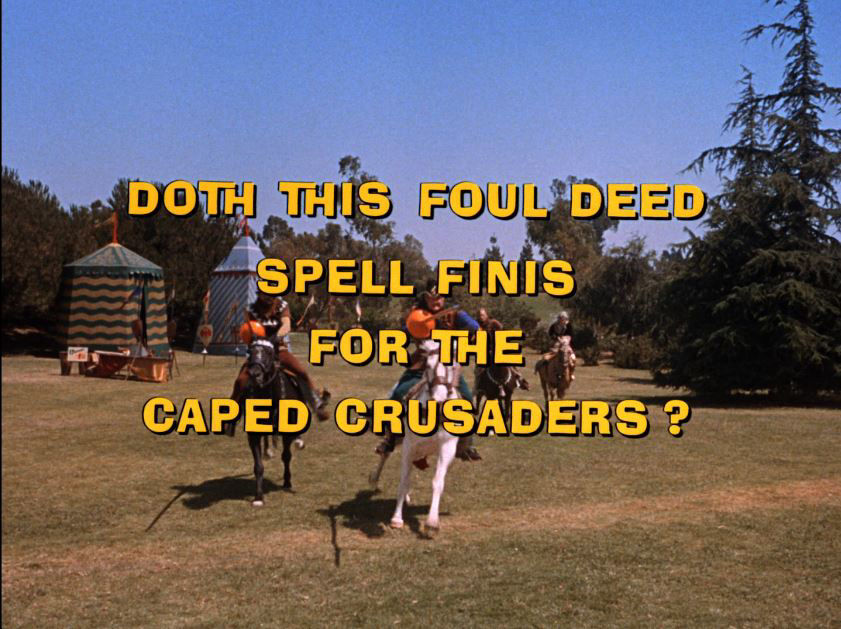
Cliffhanger narration
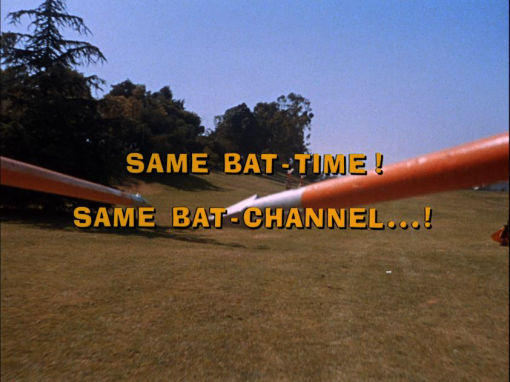
Tune in tomorrow!
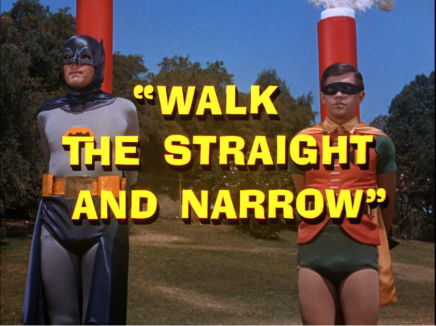
Walk the Straight and Narrow
Air date: September 8, 1966
Written by Stanley Ralph Ross
Directed by Sherman Marks
Starring Adam West and Burt Ward
Special Guest Villain: Art Carney as The Archer
The next episode begins, as all second parts do, with a recap of the previous episode beginning with narrator and producer William Dozier announcing “We have already seen…” and then showing brief scenes that freeze frame with descriptions such as “He robbeth from the rich and giveth to the poor.” When he reaches the cliffhanger, Dozier advises “Those of faint heart, look away. The most petrifying proceedings have not yet come to pass!” The opening credits begin.
Robin thinks the situation is hopeless. But Batman says “It’s always darkest before the dawn, Robin. And since we’re at the very bottom, there’s no place to go but up. The Bat-Springs! Now!”
The Dynamic Duo crouch down as much as they can, we hear a spring-like “boing” and they are launched into the air. The Archer and his Merry Marksmen strike now empty posts. The 1940s British radio show Dick Barton – Special Agent used to resolve their cliffhangers with the catchphrase “With one bound Dick was free.” In this episode, with one bound, Bruce and Dick were free.
Well, maybe not just one bound. Batman and Robin keep bouncing on their springs.
BATMAN: We’ve got your number, Archer.
ARCHER: Impossible, my dear Sheriff of Gothamham. My number’s unlisted. Marilyn, press the cheer button.
But Marilyn drops the laugh-track machine and it crashes to the ground.
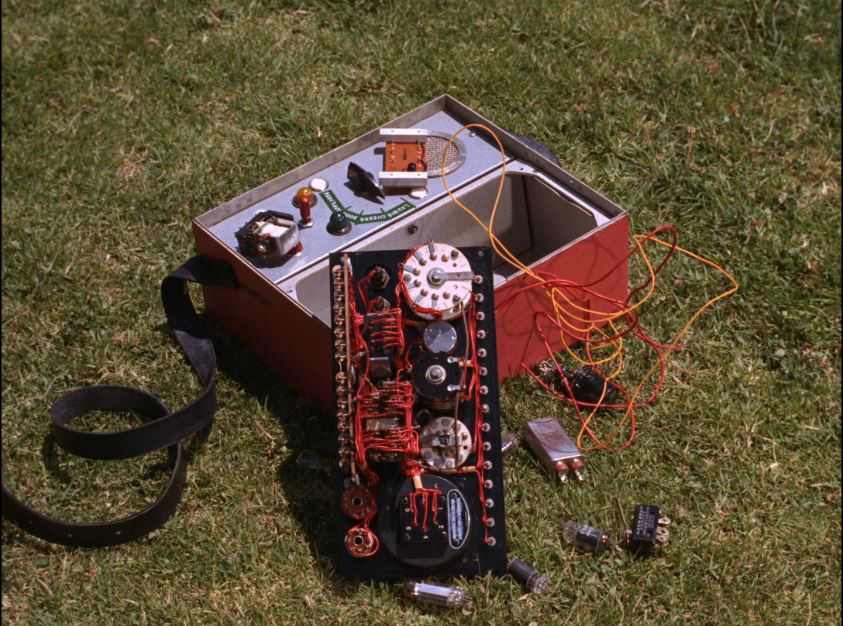
ARCHER: It’s broken! Thou hath destroyed my audience! Thou hath smashed my ego-making machine asunder and rendered me helpless! Come on!
The Archer and his band ride off. It’s funny that the Archer feels he is powerless without his pretend audience to cheer him on. As was clear from the first part, in many ways, the Archer is an actor looking for adulation. Perhaps that is why he’s adopted pseudo-medieval speech to seem above the hoi-polloi, and chosen a Robin Hood existence to feel the love of the crowd. Yes, part of it is cover for a big robbery to come, but there are easier ways to plot a robbery. The Archer most definitely sounds a trumpet before him when he does his alms. Batman’s foes often have ego problems that cause them to act in elaborate ways.
Batman decides to free Alfred rather than chase after the Archer.
In the next scene, Batman pays Allan A. Dale a visit.
DALE: Mmmm. I like that cape, Batman. Very chic. Wash and wear?
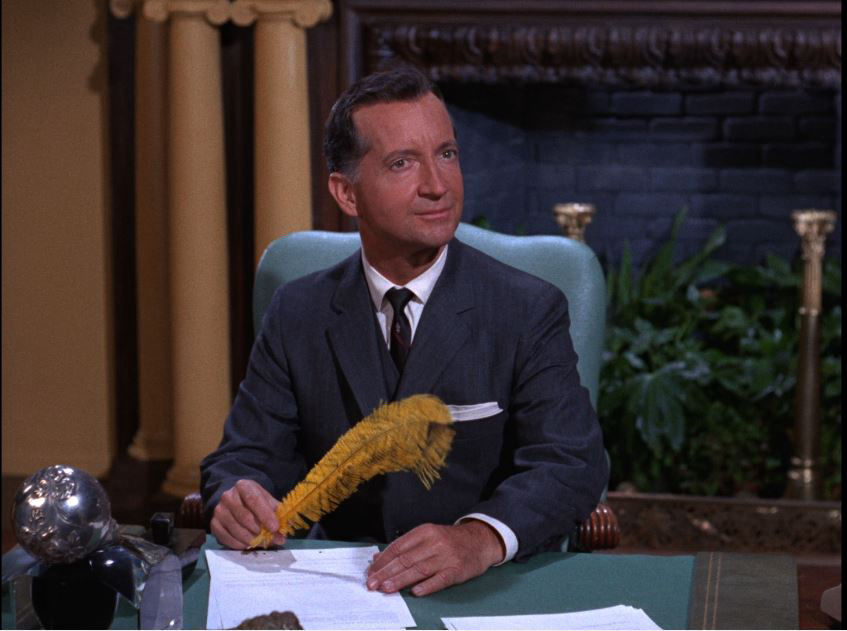
Holy Queer Coding! (The aired version cuts lines like “Isn’t it all too fabulous?” that appear in Stanley Ralph Ross’s draft script.)
BATMAN: We’re not here to discuss my wardrobe, Mr. Dale. As administrative head of the Wayne Foundation, one could presume that you’ve been in charge of the money from the beginning.
ROBIN: We checked with Bruce Wayne, and he doesn’t know a thing about it.
DALE: He doesn’t know I’m in charge of the Foundation’s money? Of course he does. He’s a rather dull chap, but he’s not that stupid.
BATMAN: Well, what about it? The ten million dollars?
DALE: Did Mr. Wayne send you here to ask me that question? Every large foundation has its secrets. And employees trusted to keep those secrets.
BATMAN: Understandably, Mr. Wayne is concerned about the handling of such a large sum and the problem of it reaching each of the 100,000 Gotham Cityites to which it’s assigned.
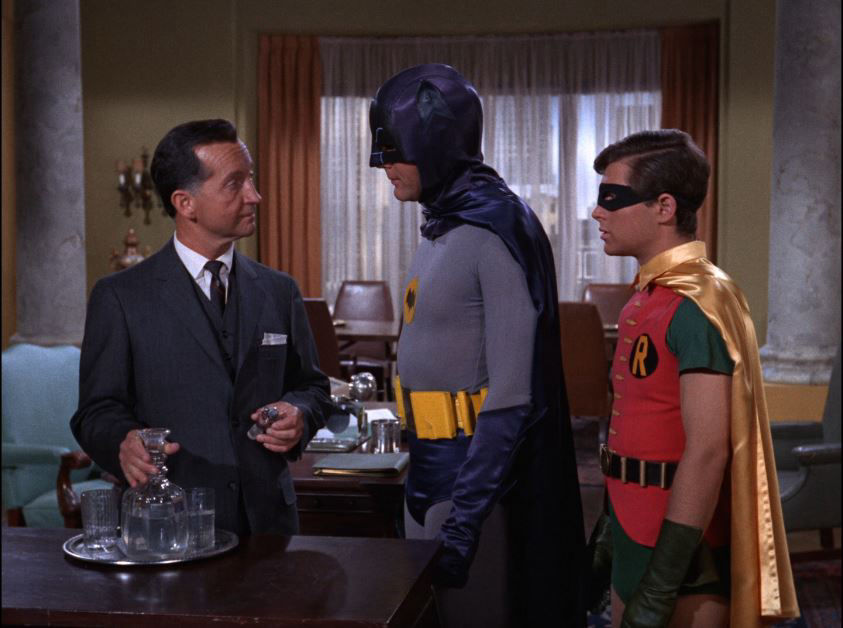
Dale assures Batman that the money (in cash, $100 bills) is coming directly from the government printing press through a reputable firm to Dale directly, although he refuses to divulge any more details of the transfer – certainly not without a signed letter from Bruce Wayne or another trustee. But Batman is less than reassured. “Do you realize, sir, what might happen if any criminal got wind of this?” But Dale holds fast.
When the Dynamic Duo leaves, Robin punches his own hand in frustration. But Batman scolds him that “No man’s honesty should be suspect without good and clear cause.” Perhaps if Robin had paid more attention in English class and realized that Allen-a-Dale is one of Robin Hood’s men, he’d have that good and clear cause.
Meanwhile, the Archer is hiding out in the basement of police headquarters. Marilyn calls this a really good idea.
ARCHER: Oh, Marilyn, Marilyn, Marilyn. Wouldst that thou couldst learn proper English. We couldst make such beautiful speeches together.
MARILYN: Oh come off it, Archer! Everybody knows that we come from the same neighborhood.
ARCHER: Be thou silent, wench! Loose lips sink ships!
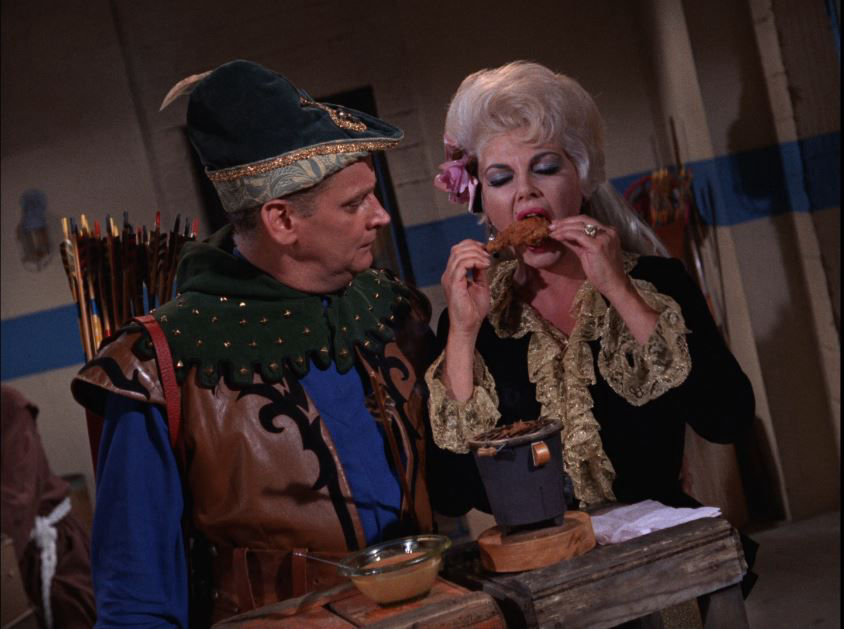
Confirmation, although none was truly needed, of what a phony the Archer truly is.
But his use of the word “ships” sparks an idea, although he doesn’t disclose what yet. Big John praises the Archer for picking this location right under the police’s own “red, veined noses” – the last place they’d look. The Archer declares that he is seldom wrong, and his men applaud, now filling in for the busted laugh track machine. The Archer is about as modest as the Sheriff of Nottingham in Reginald De Koven and Harry B. Smith’s 1890 comic opera who once sang “I never yet made a mistake / I'd like to for variety's sake.”
A knock at the door causes some concern, but it’s Allan A. Dale, who is no stranger to the Archer’s lair.
DALE: Hi ho, everybody.
ARCHER: Salutations, Allan A. Dale. What sayeth thou?
DALE: Just this, Batman and the Boy Wonder, they have a bit of a sticky wicket planned for you.
ARCHER: Sticky wicket? Thou speakest in a unique vernacular.
DALE: I speakest, as we say on Madison Avenue, about our gentleman’s agreement, Archer. I was to alert you as to the location of the money. And you were to cut me in. Try that on for size.
ARCHER: It fitteth. Pray continue.
Dale begins to tell the Archer about the armoured car when the scene changes again.
The armoured car is stopped by three explosive arrows. The armed guards leave the car but are confused when they see the street is empty. They wonder who could be shooting at them.
We see the Archer and his men with curved arrows, for shooting around corners. He explains he built it in his spare time at the prison machine shop.
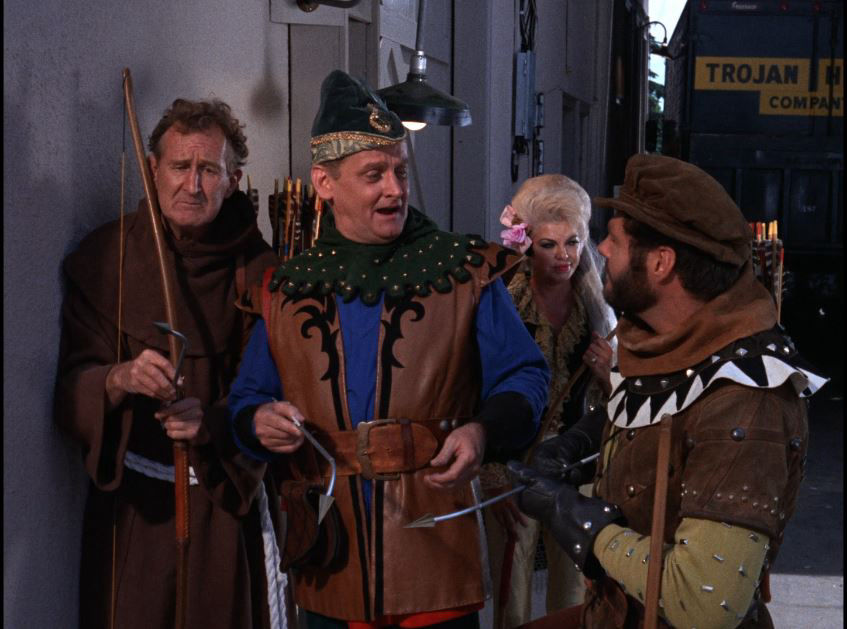
Marilyn scolds “you’re going to break your arm, patting yourself on the back.” But the Archer and his Merry Marksmen shoot three more arrows around the corner, these ones emit a purple smoke. When the guards are distracted, Marilyn hops in the armoured car and drives away.
When the guards dash after their stolen car, they find it and the money intact, which confuses them.
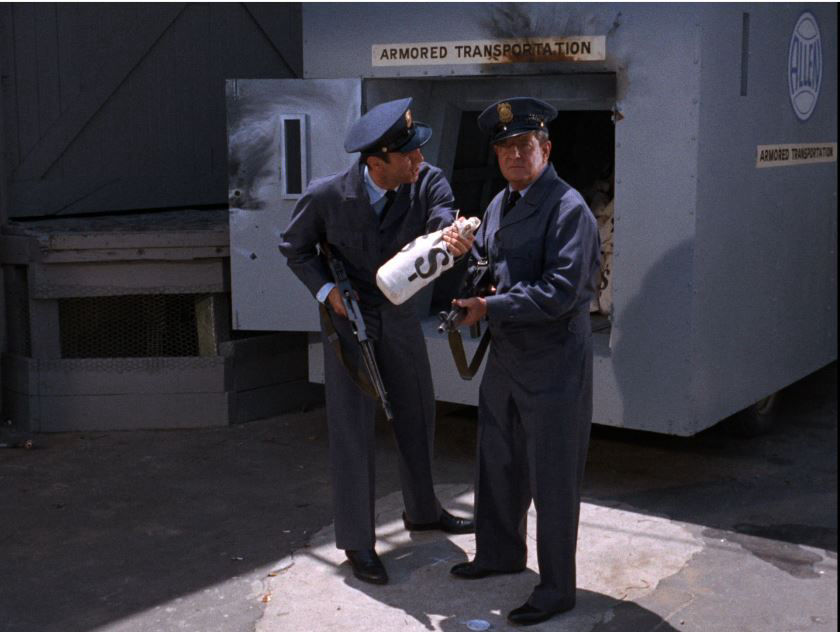
Eight hours later, Commissioner Gordon calls stately Wayne Manor to confirm that Bruce Wayne is going to attend the official ceremony at City Hall to give away the money to the poor. Gordon suggests that Bruce will be eager to meet Batman and Robin who will also be attending the event. Bruce and Dick head to their study, where he tells Alfred “We’ve got trouble … Real trouble, right here in Gotham City.” Clearly Batman is a fan of The Music Man. He tells Alfred to meet them in the Batcave.
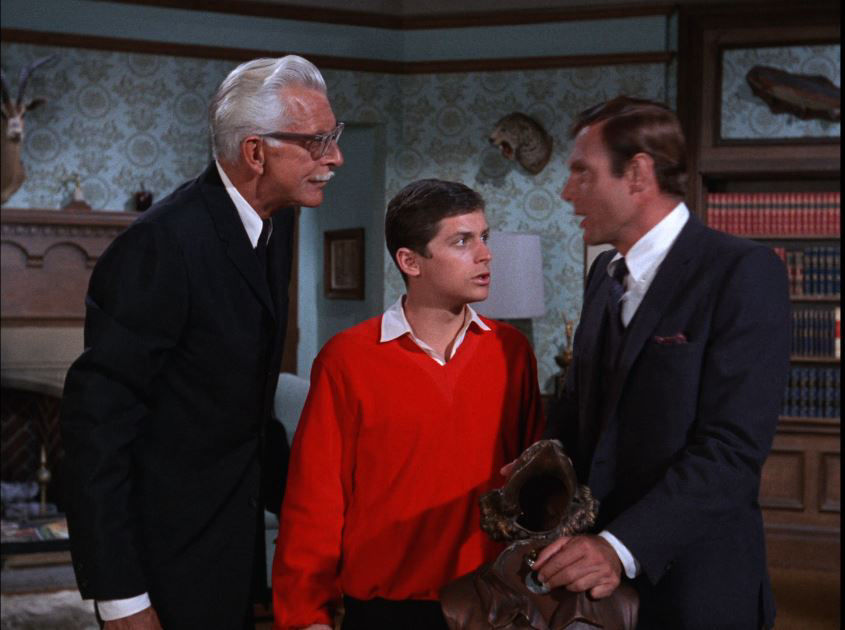
On the way down, Bruce flicks a switch that negates the automatic costume change that normally occurs when the heroes slide down to their underground headquarters. Like most things Bat-related, it has an absurdly large sign declaring its function.
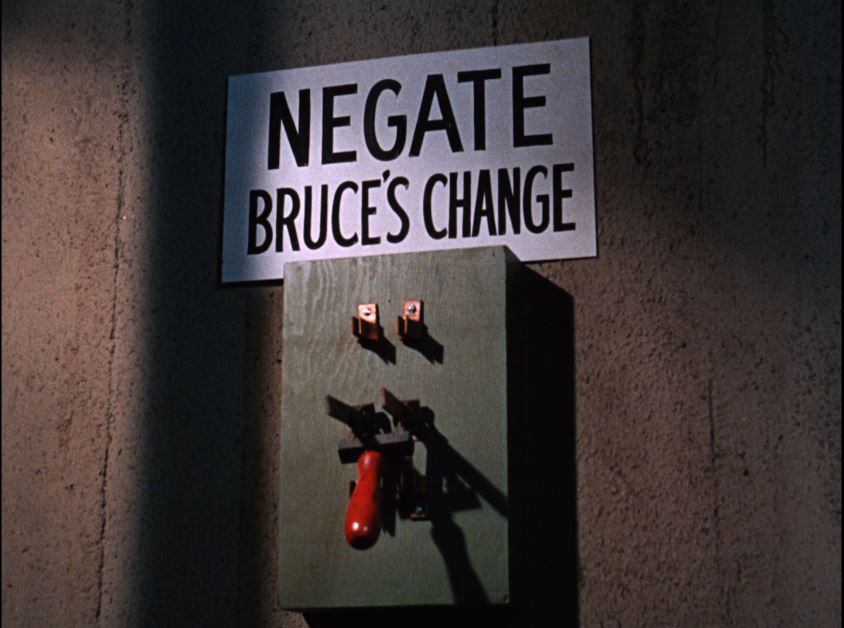
Robin is surprised to see Batman still dressed as Bruce. “Aren’t you getting dressed for work,” he asks. But Bruce explains his dilemma that Bruce Wayne must appear at the same event as Batman.
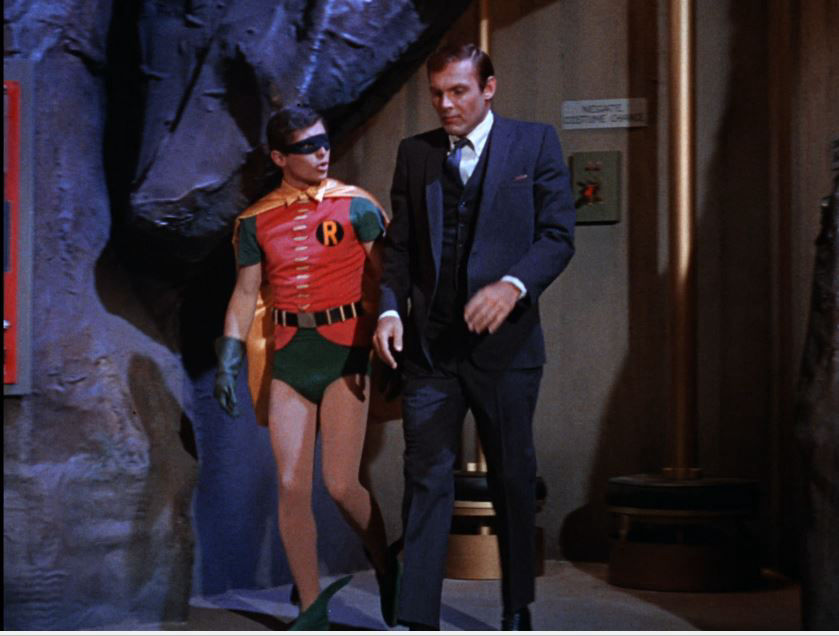
Bruce says he has the solution, but that Alfred will need to change his clothes. “My clothes, sir?”
The crowd mills about at City Hall. Bruce Wayne discusses the attempted robbery with Allan A. Dale. Dale confirms the robbery was unsuccessful, but “who knows what might have happened if we had to depend on those two up there.” The camera pans up to show Batman and Robin watching the proceedings on a nearby rooftop. Batman and Bruce Wayne in the same place and the same time? Well, no. This Batman is looks a great deal older than usual.
ALFRED (DRESSED AS BATMAN): I pray our deception succeeds, Master Robin.
ROBIN: Just puff up your chest and look virile, Alfred.
Alfred does that, and his chest looks more puffed up than Batman’s chest normally does.
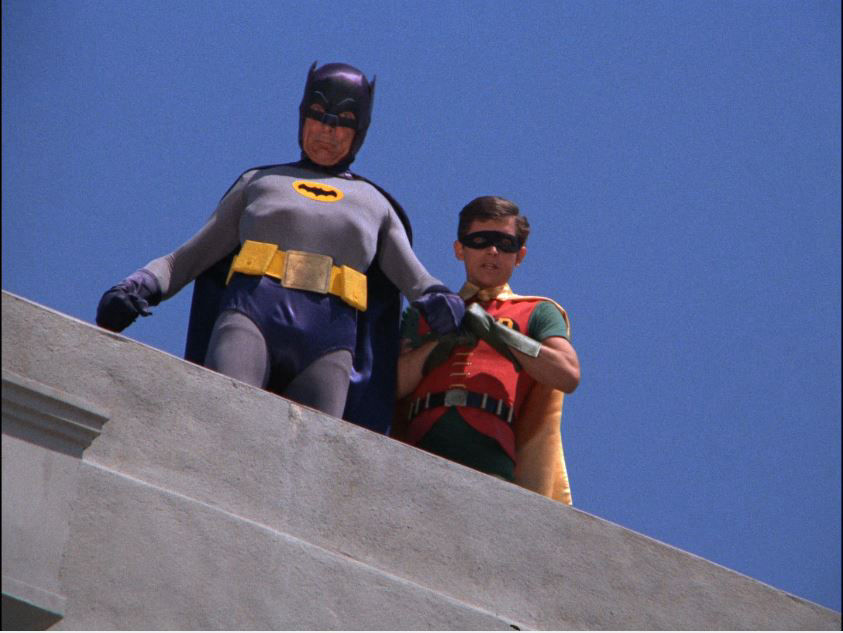
Disguise is a common theme in the Robin Hood legend – such as when Robin Hood disguises himself as Guy of Gisborne in order to rescue Little John, or as a bold harper to rescue the romantic partner of the less villainous Allen-a-Dale. It’s also a trope in comic books, as Superman and Batman often had to appear alongside their alter ego. In one comic, Superman had President John F. Kennedy impersonate him when Superman and Clark Kent had to appear on a TV show at the same time.
Commissioner Gordon chats with Bruce Wayne and Allan A. Dale. He explains that the ceremonies are being presided over by Marshall Roland, “Commissioner in charge of poor people.” I assume that Gordon doesn’t mean he’s a police commissioner, but still it almost sounds like there are two separate but not equal branches of the criminal justice system in Gotham City.
Roland declares they are carrying on the fine work of the Wayne Foundation. But Dale will have none of it. “I wish he’d get on with it. It sounds like he’s electioneering for governor.” Bruce informs him that Roland’s already been governor.
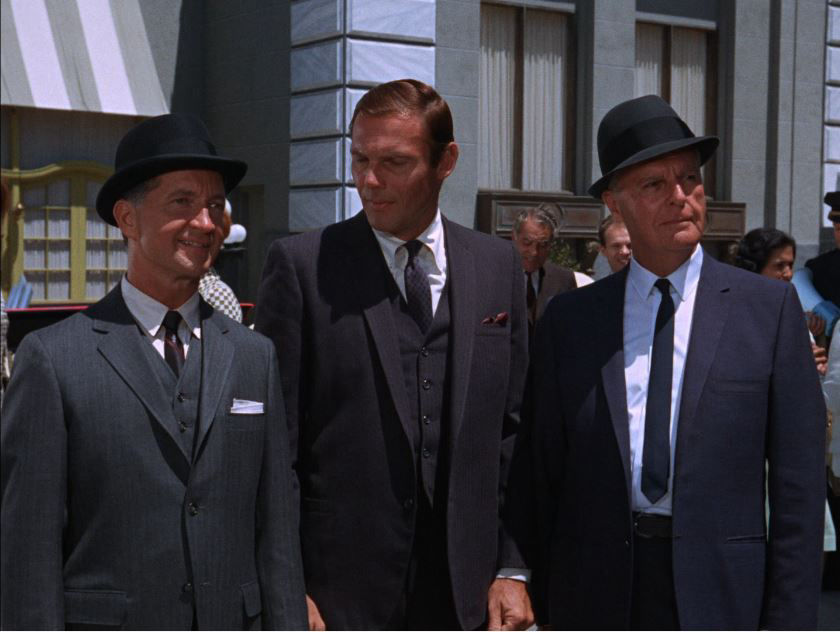
Roland says they will distribute the money in reverse alphabetical order and calls Mr. Zoltan Zorba to step forward. Zorba, an older man and likely a relative of Dr. David Zorba on the medical drama Ben Casey (after all, Sam Jaffe plays both Zorbas), comes to the podium and proudly shows off his newly received currency.
On the rooftops, Robin remarks that it looks like it’s going smoothly – famous last words.
Zorba stares at the bill in surprise and horror.
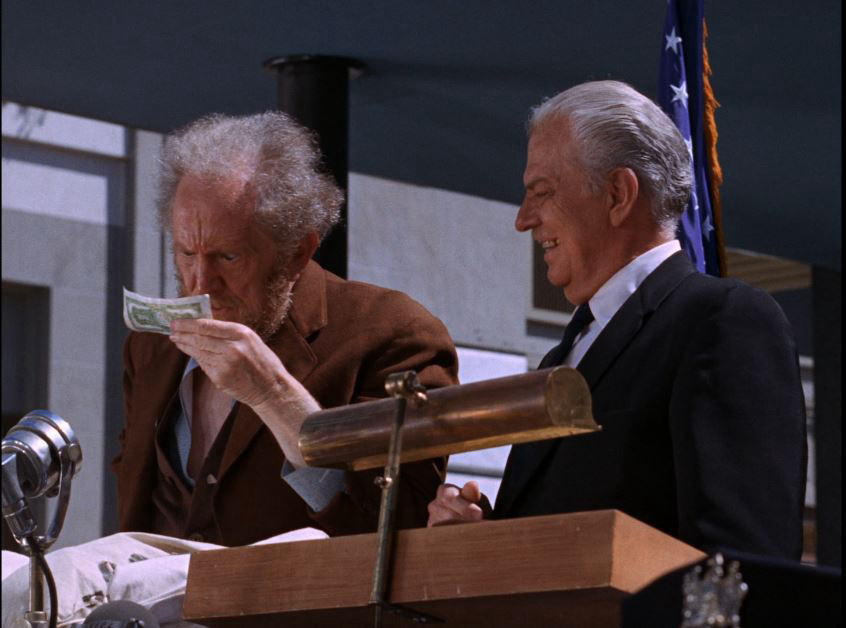
He pulls out a magnifying glass. There’s no dead president at the centre of this bill. Instead, he sees the face of the Archer.
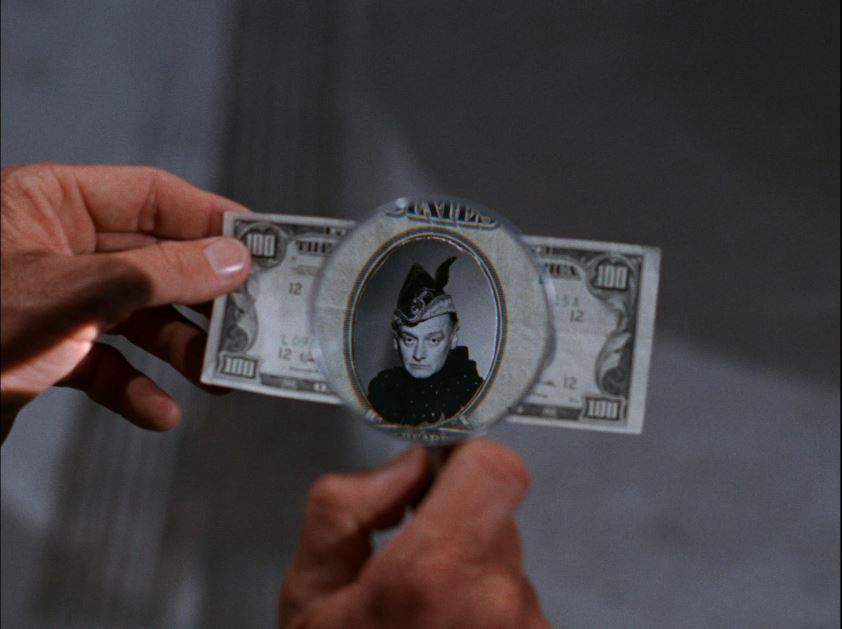
Zorba shouts that the bill is counterfeit and tells the people “They’re trying to hoodwink us!”
Realizing what happened, Gordon says he needs to call Batman down. And Bruce says that he needs to see if his insurance will cover this loss. There’s no time for Bruce and Alfred to make a switch, and so instead he hands his butler the Bat Speech Imitator, a microphone that will cause Alfred to sound like Batman and also help hide his unBatman-like moustache.
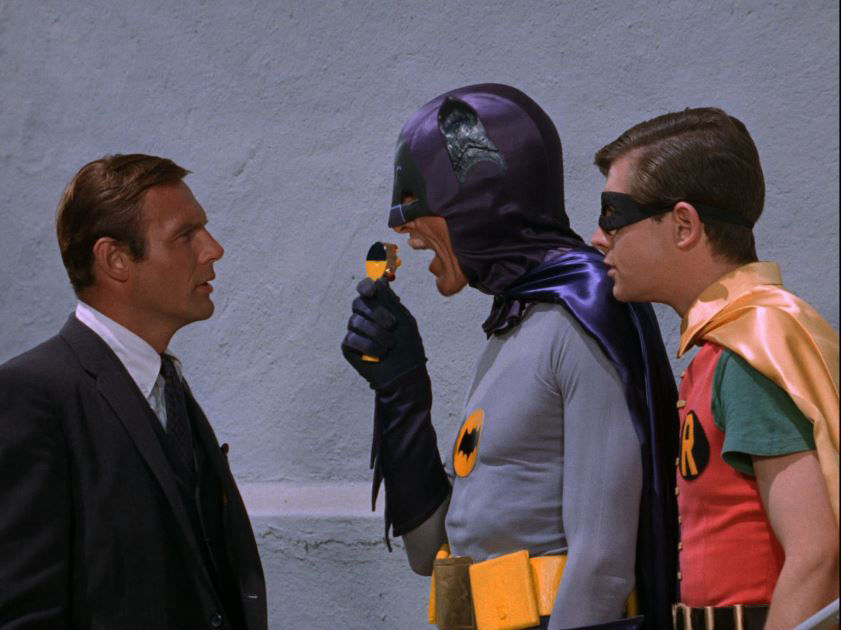
Gordon tells Robin about the counterfeit money, while Bat-Alfred stands well back. He explains that he has a cold which might be infectious. Yes, Alfred is using good social distancing to conceal his identity. “Just like Batman,” Gordon chuckles approvingly. “Always thinking of his fellow man.”
Gordon calls the theft “the crime of the century”, but Robin assures him that Batman always gets his man. Gordon glances over at Bat-Alfred, and remarks that he’s looking a bit thin these days. He advises that Batman take in some relaxation and eat all his vegetables.
Dale remarks that the robbery will probably cost him his job. “I feel that those piratical desperados have already unbuckled their swashes and fled Gotham City.” It’s a cute reference to the term “swashbuckler”, which is often used to describe Robin Hood. However, it’s not entirely accurate. Swashing is what one does to bucklers – the small shields that adventurers sometimes carry.
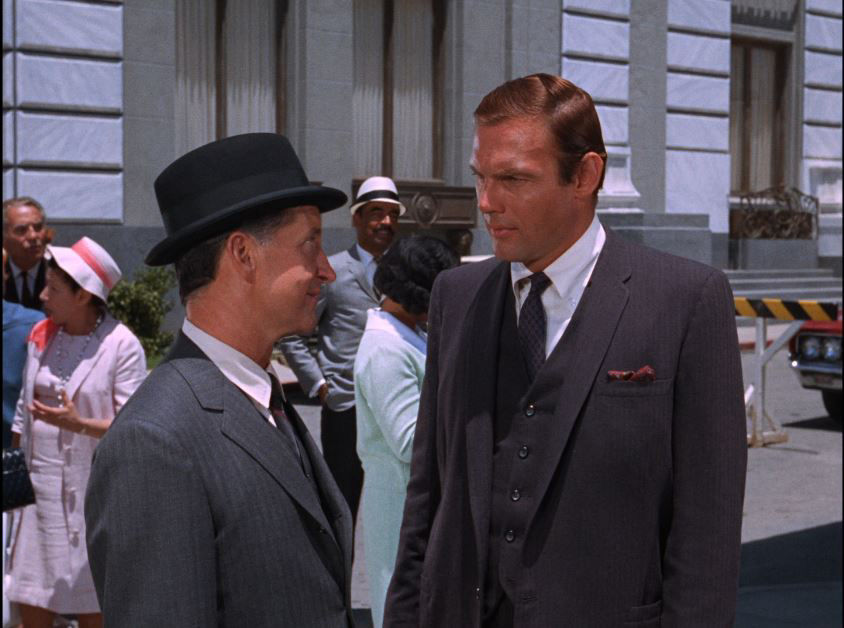
He says he’s off to go boating at Fire Cove. Dale’s quick departure arouses Bruce’s suspicions.
Back in the Batcave, Batman – the real Batman – deduces that the Archer wouldn’t be able to spend the newly-minted money with serialized numbers quickly. All the banks would be looking for it. Or rather, all the American banks. He expects they’ll store it in a Swiss bank account. “It’s as plain as the masks on our faces.”
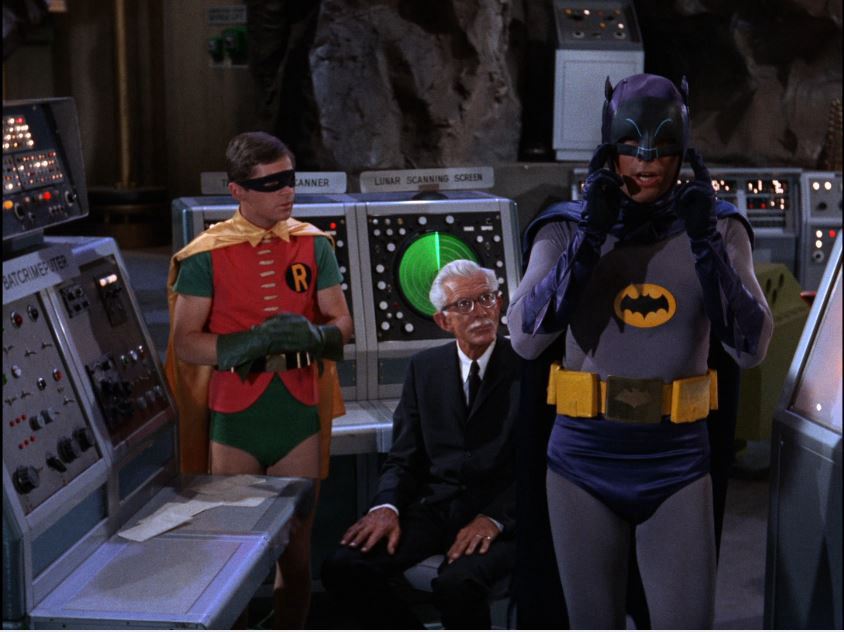
The Archer had previously joked about how his number was unlisted – just like a Swiss bank account. And Fire Cove (much like Fire Island in New York) is the last spot of land before going out to open water – the ocean which leads to Europe.
Batman shouts “To the Bat Boat, via the Batmobile!” And the Dynamic Duo roar off. The Batmobile’s great speeds draws the ire of a woman stuck in traffic.
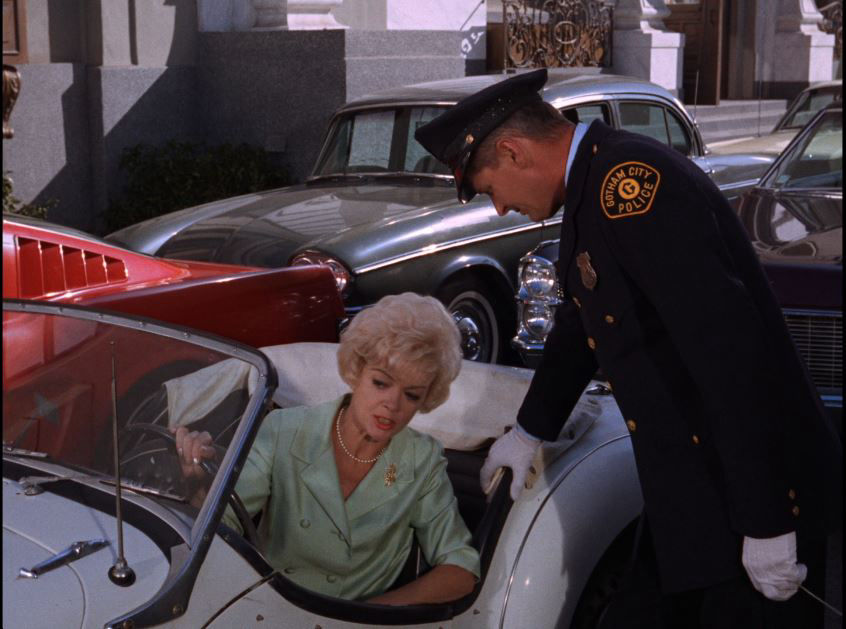
WOMAN: Officer! Officer! I don’t understand this. How come Batman gets away with driving so fast? Cutting around corners! Going through lights! Why, if I did that, I’d be in jail for the rest of my life!
POLICE OFFICER: Batman is a duly-deputized officer of the law, ma’am. And if he is not pursuing a dangerous criminal, he drives more safely than any motorist I’ve ever seen. On his off hours, he lectures on traffic safety to driving classes all over Gotham City. No, ma’am, if ever you see Batman driving speedily, you can be sure that he is endangering his life to protect yours and mine.
The other motorists stuck in traffic applaud the officer’s speech. Although honestly I suspect someone making the show used a machine very similar to the gimmick that the Archer had purloined.
A late season one episode had Batman advising Robin to buckle his seat belt – something that came at the request of the National Safety Council, aired in a time when seat belt usage was not as ubiquitous as it is today. There is a similar message here. It’s said that Robin Hood represents the good outlaw, and many versions of the legend feature Robin Hood faithfully supporting good King Richard. But speeches like this deliberately show the absurdity of a socially-acceptable, “outlaw” or vigilante. Maybe some kids thought more about driver safety, but no doubt the adult viewers got a chuckle.
The Batmobile arrives at the docks, and the Caped Crusaders speed off in their Batboat – courtesy of reused Bat-stock footage from that summer’s Batman movie.
Meanwhile at sea, it’s yo ho, yo ho, a pirate’s life for the Archer. He’s traded his bycocket (that’s a Robin Hood hat) for a pirate’s hat. And he’s also traded his medievalism for some pirate talk. Allan A. Dale, on the other hand, is dressed in an ascot and captain’s cap as if he’s out for a day at the yacht club. But while he might not dress like his criminal cohort, Dale does gaze up approvingly at that crooked cosplayer.
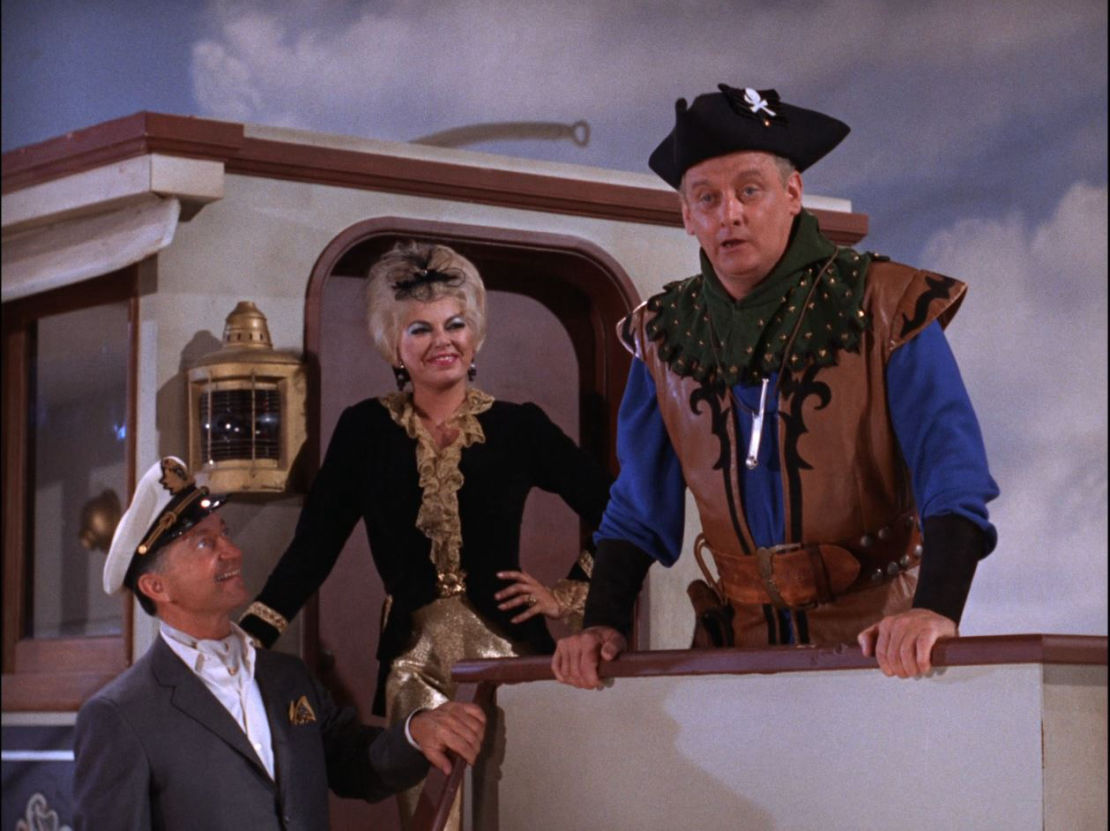
Archer blows whistle.
ARCHER: Stand by the raise the foc’s’le, the mains’le and the tops’le! And do it double-quick, or I’ll keelhaul ye!
ALLAN A. DALE: Ooo. I just love that kind of talk.
Methinks that one doeth not needeth the bat-computer to decode the coding of Allan A. Dale’s demeanour. Marilyn, thinking of her stomach as ever, plans to go down to the kitchen, or the galley as the Archer corrects her.
But reality interrupts the Archer’s fantasy when he slightly slips down a step while addressing his scurvy crew. And Dale admits that he’s getting seasick.
Batman and Robin climb aboard.
BATMAN: You’ll all be more than seasick by the time we get through with you.
ARCHER: Avast, me hearties! Draw thy bows!
BATMAN: Quick, Robin, the Bat-Shield!
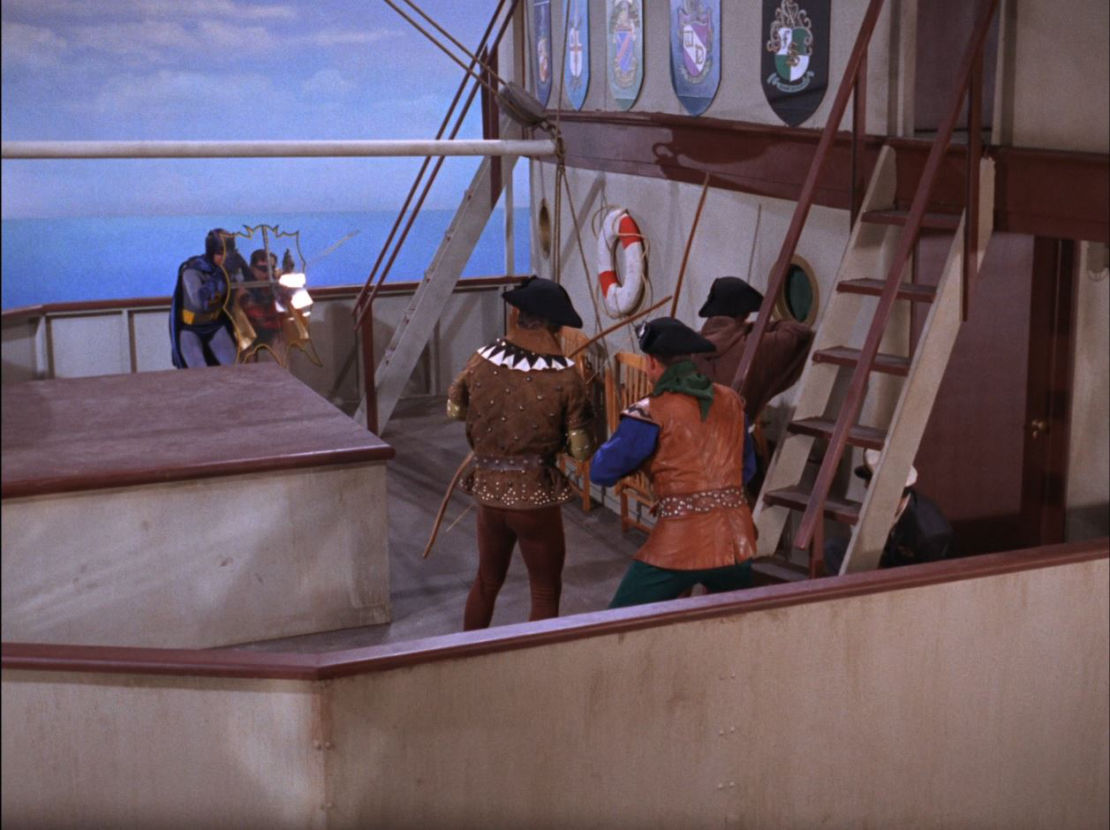
Crier Tuck and Big John’s arrows bounce off the flimsy plastic shield. The Archer orders his men to abandon bows and take to the sword. Dale supplies the men with swords, and the Archer declares “By thunder, thee will walk the plank yet!”
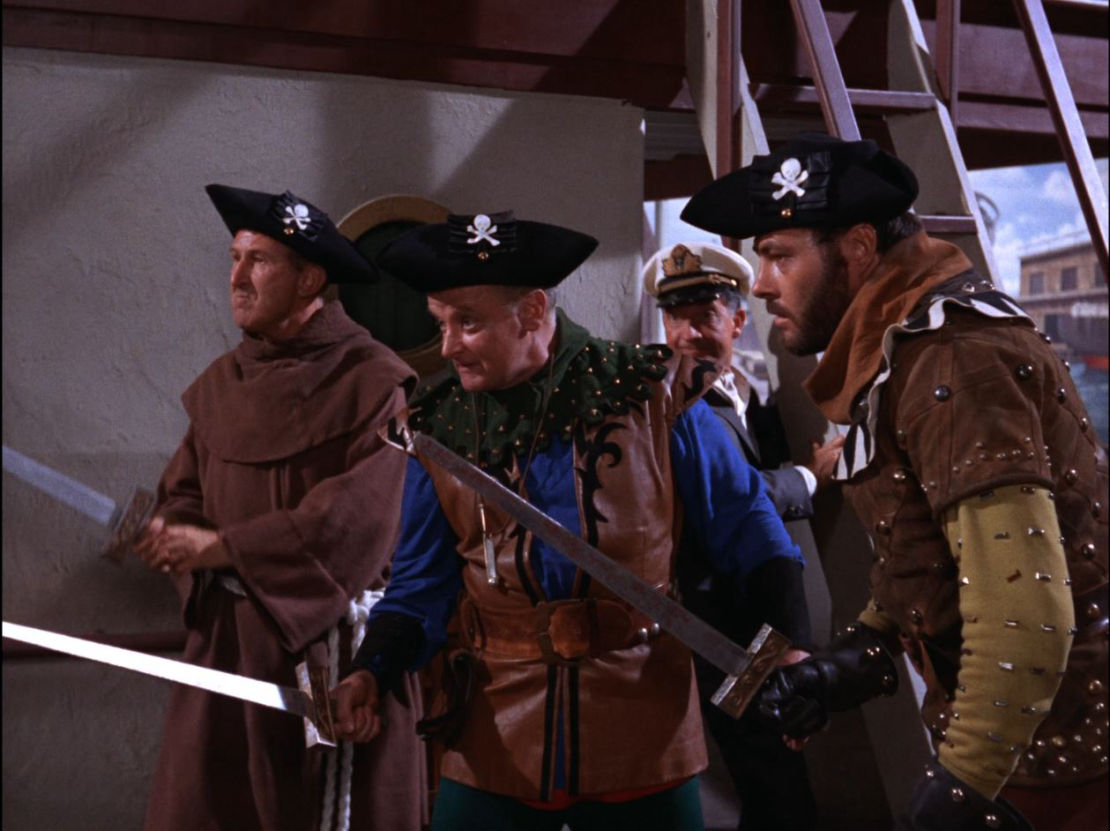
Robin exclaims “Holy Blackbeard!” Ah, now comes the swordfight – a staple of Errol Flynn films, whether it be The Adventures of Robin Hood or Captain Blood. But how can it be a swordfight if only one side is armed? Our heroes did not bring along their bat-cutlasses, it would seem. But they receive help from an unexpected quarter, when Marilyn sticks her head out a window and calls “Hey, youse guys.” She hands Batman and Robin some swords.
Batman gets into the medieval spirit of the episode by saying “I doff my cowl to you, Maid Marilyn.” She seems tickled pink at the acknowledgement.
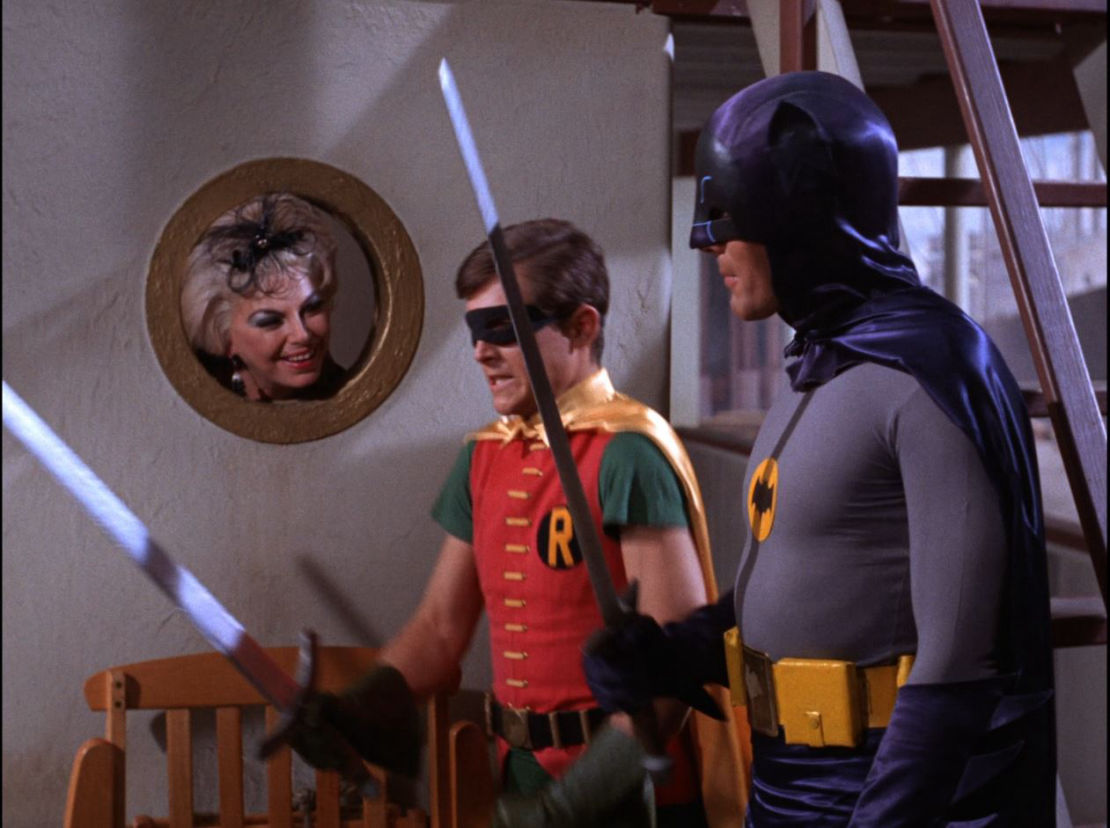
The swordfight (once again with medievalized comic book sound effects) is short-lived, and the Archer’s crew is quickly disarmed. Batman surveys the situation and declares “Fair is fair!” and the heroes throw their swords away.
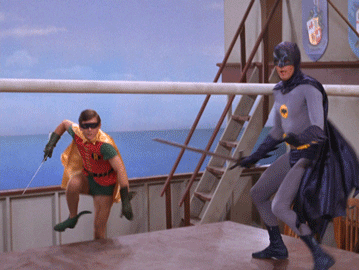
It’s similar to the fair play in The Adventures of Robin Hood, when Errol Flynn kicks the fallen sword over to his enemy. “Your sword, Gisbourne!”
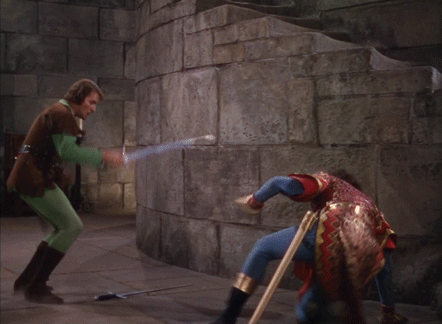
The fight resumes with the kicks and punches more commonly associated with Batman’s adventures. But the Caped Crusader does homage classic cinematic swashbucklers again when he swings on a rope to save Robin from the Archer.
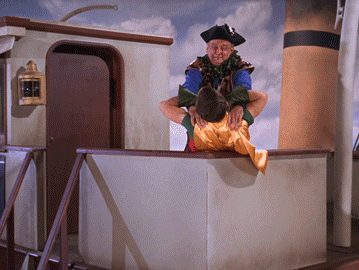
The Archer is defeated and quotes an obscure playwright’s Julius Caesar when he asks “Et tu, Brute?” (pronounced as the English word “brute” and not the phrase’s more common pronunciation of bru-tay). Then he collapses and the Archer’s hat falls off revealing the bald patch that his fanciful hats had hidden.
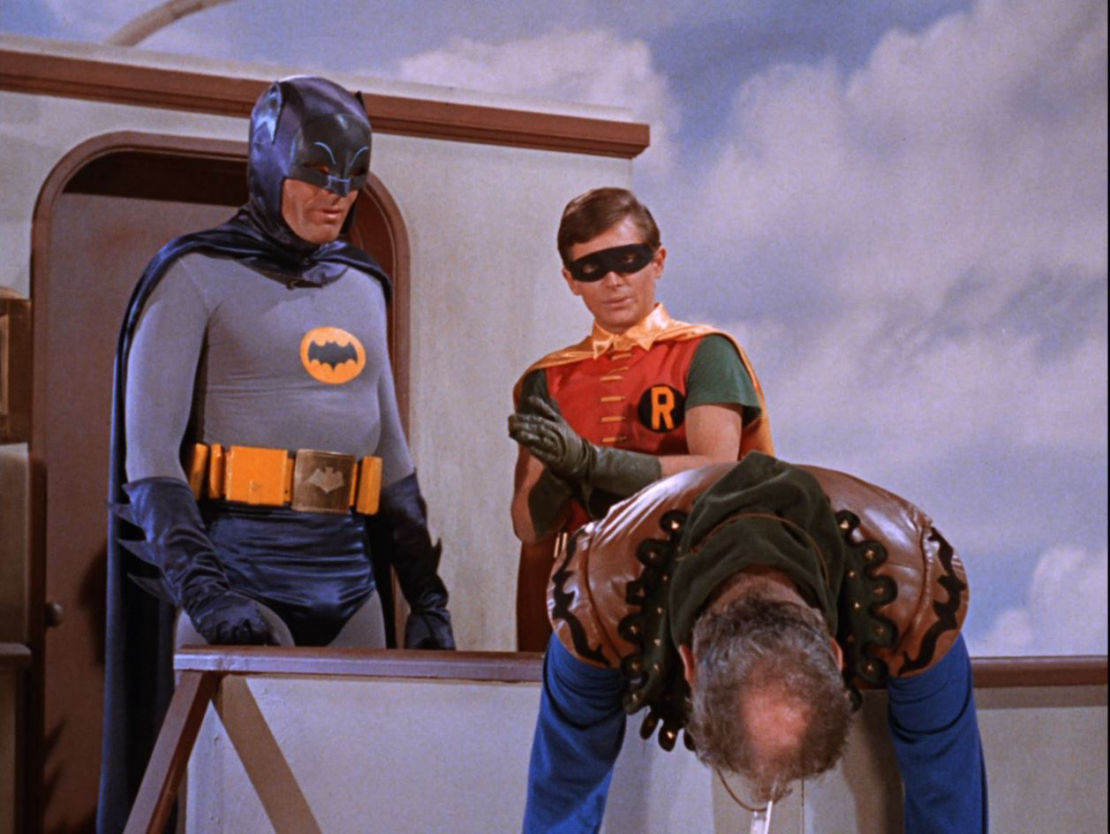
The episode ends, much as the first episode began, on the grounds of stately Wayne Manor. Bruce and Dick are practicing their archery but they both hit an outer circle and not the bull’s eye. Alfred offers to give them a few pointers which they graciously accept. That is, until Alfred places an apple on Dick’s head.
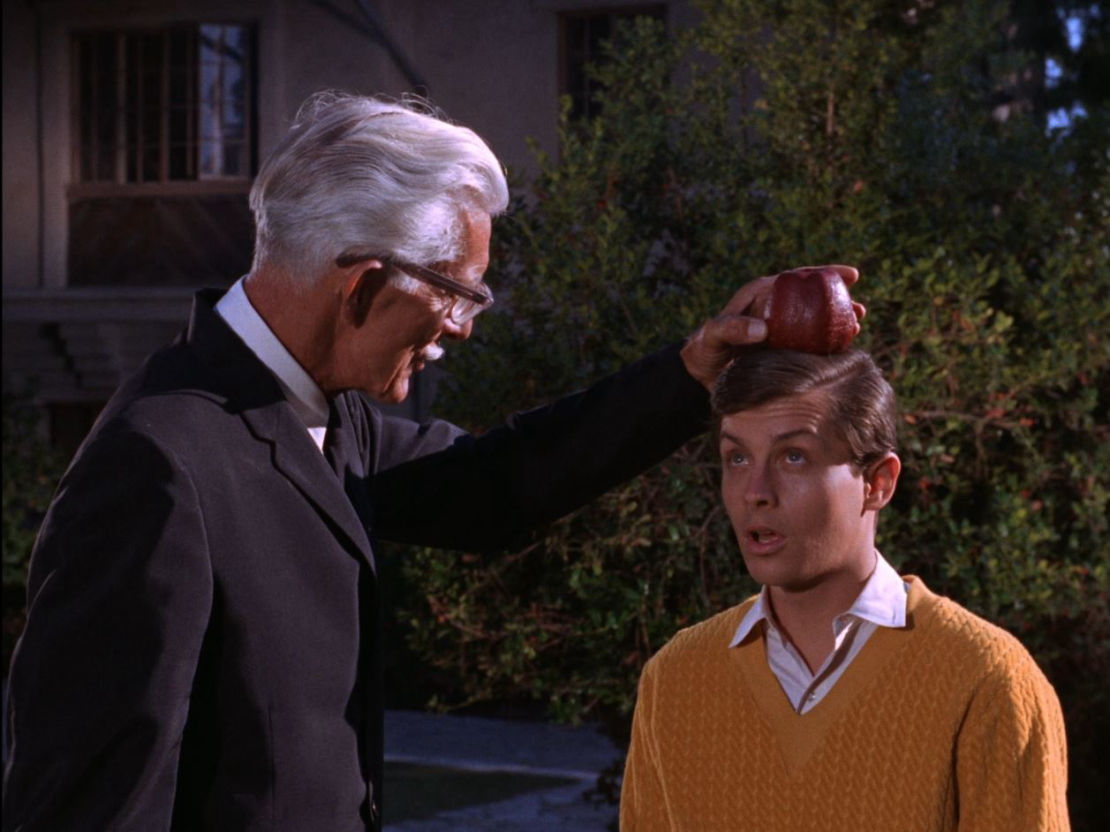
ALFRED: I’ll show you that my nickname of William Tell was no jest.
DICK: Uh, I’d rather not Alfred. Not that I don’t trust you or anything…
ALFRED: Oh?
BRUCE: Dick is right, Alfred. We shouldn’t take any unnecessary chances.
Instead, Dick rests the apple on one of the arrows imbedded in the target. Alfred explains proper archery technique, even as his aged hands quiver a bit, and he lets fly. The arrow lands inches below the apple. A horrified Dick exclaims “Right between the eyes.”
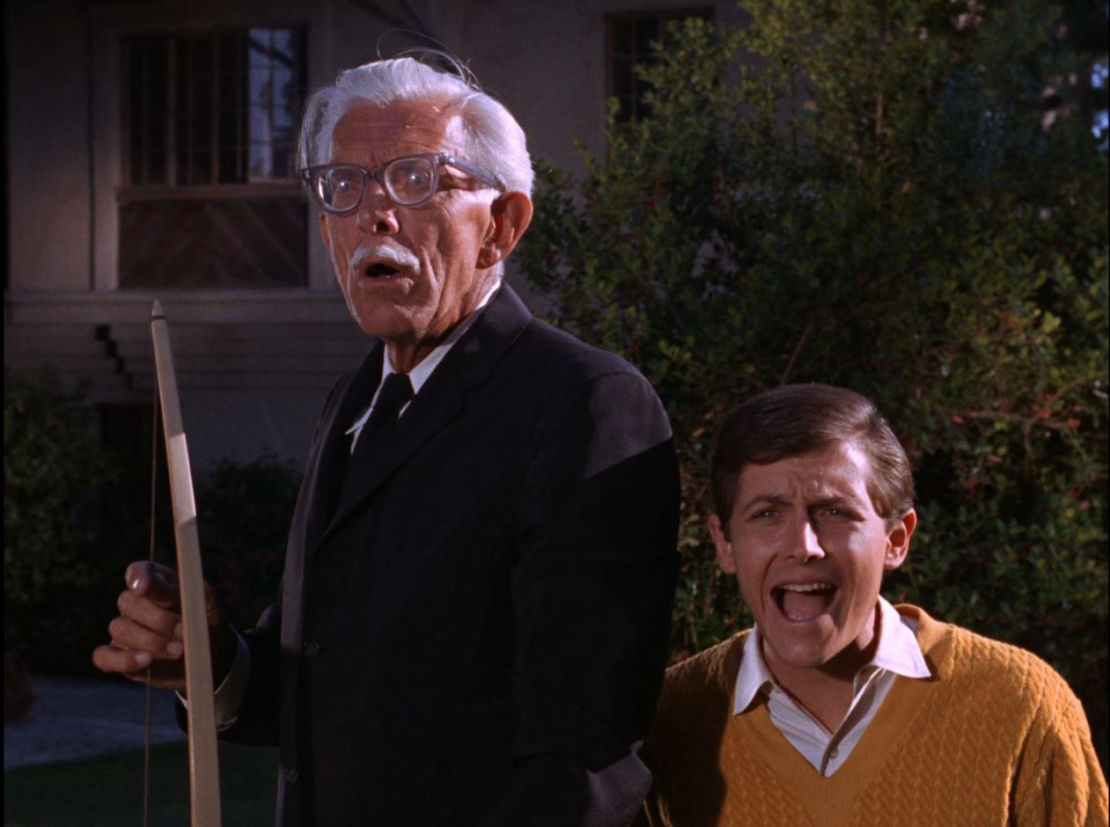
A sheepish Alfred makes his exit, claiming he forgot to dust the Batcave.
The first episode featured Alfred successfully performing Robin Hood’s most famous feat of archery – the splitting of the arrow. This episode doesn’t successfully replicate the feat of that other famous medieval archer, perhaps to discourage kids from imitating William Tell.
The Archer wasn’t the only medievalist malefactor or bycocketed blackguard that the Dynamic Duo faced in Batman’s second season. Van Johnson plays “The Minstrel” in two episodes, who dresses in garb that would fit right in with the Archer’s gang.
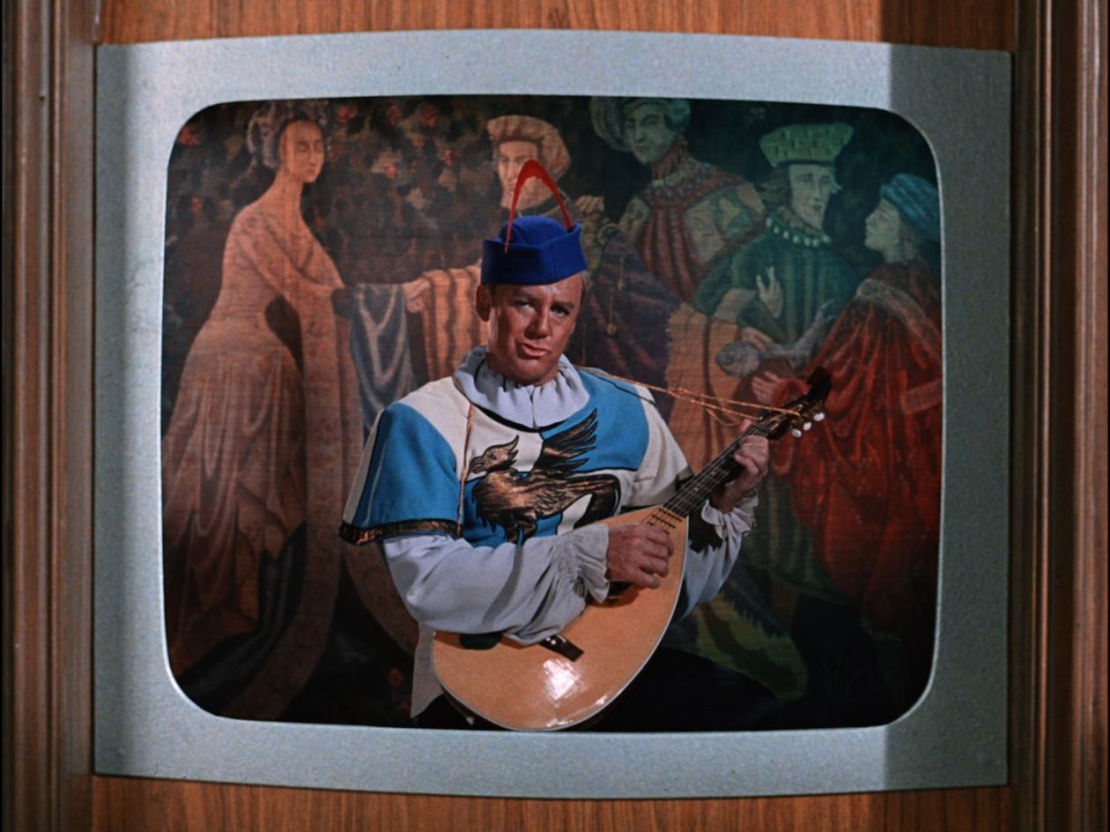
The Archer returned to bedevil Batman in issue 18 of Batman ’66 (cover dated February 2015), comics that replicate the style of Adam West’s Bright Knight. In “The Sheriff of Crime” by writer Tom Peyer and artist Dave Bullock, the Archer had changed his M.O. Disguised as a Cathar monk, the Archer steals some of the police’s modern equipment – including a computer “no larger than a refrigerator, housing a full megabyte of memory.” The Archer gives the gizmo a legendary name.
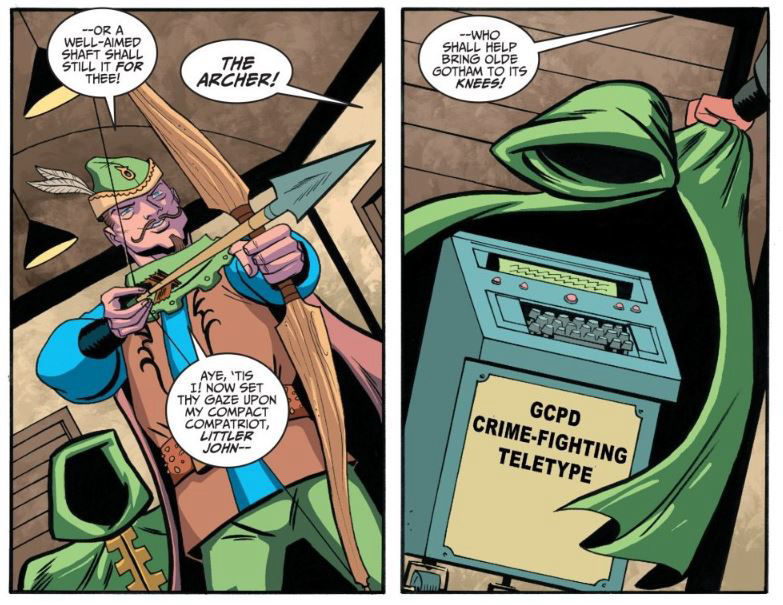
Batman and Robin deduce that the Archer’s new game is to “take from the police and give to the crooks”. The criminals are armed with such police gadgets as handcuffs, billy clubs, and even lie detectors to extract information. Batman defeats his foe by challenging him to a jousting match – a fairer one than that of the TV series.
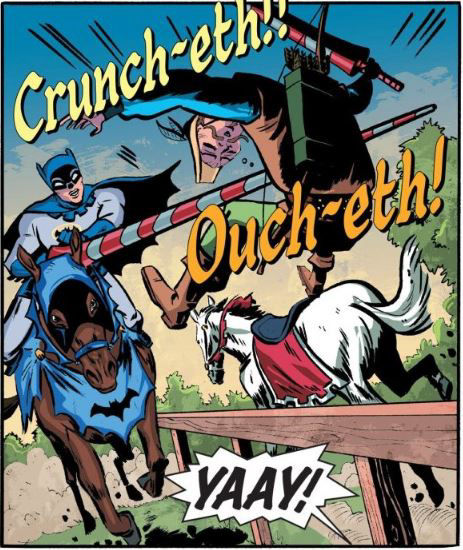
Aside from a couple other token appearances in the comic, the Archer just hasn’t had the staying power of other villains created for the TV series, such as King Tut or Egghead. The regular writer of the Batman ’66 comic Jeff Parker resisted using the Archer, as Art Carney’s joyless performance did not create a favourable impression.
Indeed, one could point to “Archer” episodes of Batman as an example that the show’s pop culture popularity would soon fade quickly. The TV series limped into a shortened third season and was then cancelled.
But would the end of the TV show also spell the end of the Dynamic Duo? Tune into the next part – same Bat-Time, same Bat-Channel!
NEXT:
PART 7 - Robin Leaves the Nest (1969 - 1975)
PART 8 - The Dynamite Duo and Goodbye, Hudson University (1975 - 1980)
PART 9 - Robin No More: The Birth of Nightwing (1980 - 1984)
PART 10 - Reboots and Retcons (1984 - Present)
PREVIOUSLY:
PART 1 - The Golden Age of Comics and the Development of the Kid Sidekick
PART 2 -What's In A Name? Robin and Robin Hood
PART 3 - Early Adventures (including Robin's origin)
PART 4 - Batman and Robin meet Robin Hood in The Rescue of Robin Hood (Detective Comics #116)
PART 5 - The Caped Crusaders in 1950s and 1960s Comic Books and Television
Contact Us